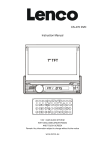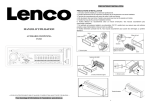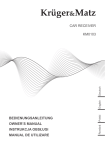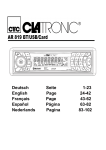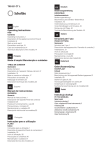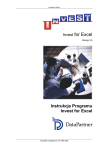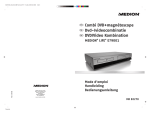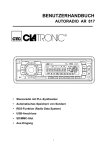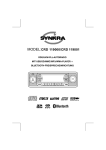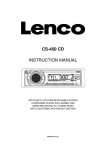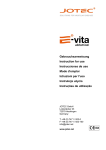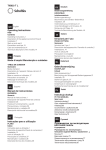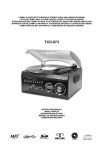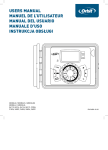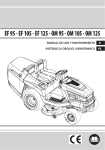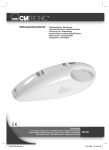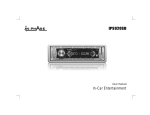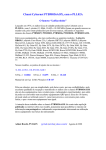Download montage
Transcript
CS-321 MODE D'EMPLOI Système audio portable Radio synthétiseur PLL stéréo Mise en mémoire automatique Avec fonction RDS (Radio Data System) Interface USB Interface SD/MMC Entrée auxiliaires for information and support,www.lenco.eu 1 TABLES DES MATIERES Montage ............................................... 3 Mise en mémoire automatique et Montage din face avant/arriere ............. 3 Balayage des stations ....................... 9 Montage façade DIN (Méthode A)......... 3 Mise en mémoire d'une station ......... 10 Fonctionnement du RDS (radio data Montage de l'appareil ........................ 3 Démonter l'appareil ........................... 4 system)................................................. 10 Montage face arrière DIN (Méthode B) . 5 Fonctionnement USB ........................... 11 Câblage................................................ 6 Fonctionnement SD/MMC .................... 12 Fonctionnement.................................. 7 Caractéristiques techniques.............. 13 Général ................................................. 7 Dépannage .......................................... 14 Allumer/éteindre l'appareil................... 7 Réglage du son................................... 7 Affichage ............................................. 9 Ecran à cristaux liquides ..................... 9 Entree auxiliaire .................................. 9 Fonctionnement de la radio .................. 9 Sélection du mode radio.................... 9 Sélection de la fréquence.................. 9 Sélection d'une station ...................... 9 2 MONTAGE montage, veuillez consulter la section illustrée ci-dessous. Remarques : Installez l'appareil à un endroit où il ne gênera pas la conduite. Avant de procéder au montage de l'appareil, branchez-le provisoirement et vérifiez que les raccordements fonctionnent et que le système marche. Utilisez uniquement les pièces fournies avec l'appareil pour garantir un montage correct. L'utilisation de pièces non-autorisées peut entrainer des dysfonctionnements. S'il s'avère nécessaire de percer des trous ou de modifier le véhicule, demandez conseil à votre concessionnaire le plus proche. Installez l'appareil à un endroit où il ne gênera pas le conducteur et ne pourra pas blesser le passager en cas de freinage brusque, par exemple en cas d'arrêt d'urgence. Si l'angle de montage est supérieur à 30° par rapport à l'horizontale, il est possible que les performances de l'appareil ne soient pas optimales. MONTAGE FACADE DIN (Méthode A) Logement de l'appareil Cet appareil peut être installé sur tout tableau de bord disposant d'un logement comme illustré ci-dessous : 53mm 182mm Montage de l'appareil Effectuez un test de toutes les connexions puis procédez au montage de l'appareil en respectant les étapes suivantes : 1. Vérifiez que le contact est coupé, puis débranchez le câble de la borne négative (-) de la batterie du moteur. 2. Débranchez le câble électrique et l'antenne. 3. Soulevez le haut puis tirez dessus pour l'enlever. 4. Les deux clés fournies permettent de dégager les deux languettes à l'intérieur du compartiment de l'appareil pour que vous puissiez le retirer. Insérez les clés aussi profondément que possible (encoches vers le haut) dans les logements appropriés au milieu des côtés gauche et droit de l'appareil. Faites ensuite glisser le support de montage pour le sortir. 30 Evitez d'installer l'appareil dans un endroit exposé à de fortes températures (tel qu'un endroit directement exposé aux rayons du soleil, à de l'air chaud, ou près du chauffage), à de la poussière, de la saleté ou des vibrations excessives. MONTAGE DIN FACE AVANT/ARRIERE Cet appareil peut être monté soit en façade (montage façade DIN classique) ou par l'arrière (montage arrière DIN, en utilisant les trous des vis prévus à cet effet et situés sur les côtés du boitier). Pour plus de renseignements sur les méthodes de Sleeve L Key Outer Trim Ring R Key 3 MONTAGE 5. Montez le support en encastrant celui-ci dans la découpe du tableau de bord et courbez les languettes situées autour du support à l'aide d'un tournevis. Toutes les languettes ne pourront pas être utilisées, choisissez celles qui seront les plus utiles. Courbez les languettes appropriées derrière le tableau de bord pour fixer le support. située sous le tableau de bord. Cette attache permet également d'assurer la mise en terre correcte de l'appareil. Veillez à installer l'extrémité courte de l'écrou de montage sur l'arrière de l'appareil et l'extrémité longue sur le tableau de bord. Spring Washer Hex Nut Metal Strap Mounting Bolt Dashboard Plain Washer Tabs Tapping Screw Screwdriver 9. Rebranchez le câble sur la borne négative (-) de la batterie du véhicule. Remettez ensuite la façade externe en place. Démonter l'appareil Sleeve 6. Rebranchez le câble électrique et l'antenne en veillant à ne pincer aucun fil ou câble. 7. Faites glisser le support à l'intérieur du logement autoradio jusqu'à ce qu'il soit fermement enclenché. 8. Pour fixer l'appareil encore plus solidement, utilisez l'attache métallique fournie pour retenir l'arrière de l'appareil en place. Utilisez le matériel fourni (Vis hex (M5mm) et rondelle à ressort) pour fixer l'une des extrémités de l'attache sur l'écrou de montage à l'arrière de l'appareil. Si nécessaire, pliez l'attache métallique pour l'adapter à la zone de montage du véhicule. Utilisez ensuite le matériel fourni (vis autotaradeuse (5x25 mm) et rondelle simple) pour relier l'autre extrémité de l'attache métallique à la partie métallique solide du véhicule 1. Vérifiez que le contact est coupé, puis débranchez le câble de la borne négative (-) de la batterie du moteur. 2. Retirez l'attache métallique fixée à l'arrière de l'appareil (le cas échéant). 3. Soulevez le haut de la façade externe et tirez dessus pour la retirer. 4. Insérez les deux clés fournies dans les fentes situées au milieu des côtés gauche et droit de l'appareil, puis sortez l'appareil de son logement dans le tableau de bord. 4 MONTAGE support de montage et l'attache métallique ne MONTAGE FACE ARRIERE DIN (Méthode B) Si vous avez un véhicule de la marque Nissan ou Toyota, veuillez suivre les consignes suivantes. servent pas pour un montage selon la méthode B. Utilisez les orifices affichant T (Toyota), N (Nissan) sur les côtés de l'appareil pour fixer l'appareil aux crochets de montage radio d'usine de votre véhicule. Side View showing T, N Screw Screw Hook Dashboard or Console Fixer l'appareil aux crochets de montage radio d'usine. 1. Utilisez un tournevis pour dévisser les vis sur les côtés gauche et droite de l'appareil et retirez les crochets. 2. Alignez les orifices du crochet de montage sur les orifices de l'appareil. Resserrez les vis (5x5 mm) de chaque côté.Remarque : la façade externe, le 5 CABLAGE 6 FONCTIONNEMENT GENERAL ALLUMER/ETEINDRE L'APPAREIL Appuyez sur l'une des touches (1) pour allumer l'appareil. Lorsque l'appareil est en marche, appuyez sur la touche (1) pour éteindre l'appareil. station avec une identification différente mais les mêmes informations TP. Lorsque les informations TP ne sont plus reçues sur la station sélectionnée, l'autoradio démarrera la recherche d'une station de programmation similaire, au bout de 30 secondes si RETUNE SHORT est sélectionné, ou bien au bout de 90 secondes si RETUNE LONG est sélectionné. Si aucune station PI similaire n'est trouvée au bout d'un cycle de recherche, l'autoradio cherchera la prochaine station émettant des informations routières. - Mode ALARM TA : Si ce mode est sélectionné, le mode de syntonisation automatique n'est pas activé. Par contre, un double bip (ALARME) est émis. Lorsque la station trouvée ne contient pas d'informations TP pendant quelques secondes, le bip REGLAGE DU SON Appuyez rapidement sur la touche SEL(3) pour sélectionner le mode de réglage de votre choix. Le mode de réglage défilera selon l'ordre suivant : → VOL → BAS → TRE → (volume) (graves) BAL → FAD → LOUD (aigus) (balance) (fader) Tournez le bouton rotatif (3) vers la droite ou vers la gauche pour ajuster la qualité du son. Appuyez sur la touche SEL (3) pendant plusieurs secondes. Les fonctions suivantes seront proposées. TA SEEK ou ALARM→PI SOUND ou MUTE→RETUNE L ou S→ MASK DPI ou ALL→ BEEP 2’nd,ALL ou OFF a) TA SEEK OU TA ALARM - Mode TA SEEK : Si la station sélectionnée ne reçoit plus de signal TP pendant plusieurs secondes, l'autoradio recherchera la prochaine 7 FONCTIONNEMENT se fera entendre. Lorsque les informations TP de la station sélectionnée sont perdues, le bip se fait entendre. Lorsque la station sélectionnée n'a pas de signal RDS, “PI SEEK” est alors supprimé. b) PI SOUND ou PI MUTE Lorsque la fonction AF est intégrée à la station C201, l'AF peut passer à 100 MHz, ce qui n'est pas une véritable AF (PI différent pour la même AF) avec un “DIP” court. Si une voiture va et vient entre deux points de cette zone, une oscillation peut se produire, car un code PI différent peut être reçu à partir de 100 MHz avec le PI “XXX”. L'autoradio possède un dispositif spécial pour réduire ce risque inévitable, mais celui-ci ne peut toutefois pas être entièrement écarté. Dans ce cas, 2 modes peuvent être sélectionnés : d) 98 100 90 PI: C201 100 PI: XXX - Mode PI SOUND : Lorsque différents sons PI (DIP) se font entendre de temps en temps, le son DIP sera émis pour une courte durée. - Mode PI MUTE : Dans la même situation, le son sera coupé pour une courte durée. c) Mode RETUNE L ou RETUNE S Le délai initial de recherche automatique d'informations routières (TA) ou d'identification de programme (PI) est sélectionné. Si l'information d'identification du 8 programme n'est pas détectée durant le délai de syntonisation fixé, la radio cherchera la prochaine station ayant le même PI. Si aucune station ayant le même PI n'est détectée au bout d'un cycle de recherche, la radio revient à la dernière station et attend quelques minutes qu'un code PI soit reçu. - Mode RETUNE L : Délai de 90 secondes. - Mode RETUNE S : Délai de 30 secondes. Mode MASK DPI ou MASK ALL La fréquence AF (disposant d'un PI différent ou d'un signal NO RDS avec une intensité de champs élevée) est masquée durant le processus de vérification du PI lors d'une recherche AF. L'appareil ne recherche pas cette AF (DIP) durant plusieurs minutes. Si jamais l'appareil ne trouve aucun signal AF ou NO RDS avec intensité de champs élevée, si la véritable fréquence alternative est masquée par erreur en tant que DIP par des interférences, l'appareil hésite à rechercher les véritables AF. Pour cette raison, l'appareil dispose de l'option MASK DPI qui ne masque pas l'AF avec un signal NO RDS et une intensité de champs élevée. En mode MASK DPI, l'autoradio émet une sonnerie d'alerte ou reste muette (selon le paramétrage PI SOUND ou PI MUTE) sur une station AF ayant un signal NO RDS et dont l'intensité de champs est supérieure à celle de la station AF actuellement sélectionnée. Ces phénomènes arrivent toutefois rarement et l'utilisateur aura rarement l'occasion d'entendre la sonnerie d'alerte en Europe. - Mode MASK DPI : FONCTIONNEMENT e) Ne masque que les stations AF dont le PI ne correspond pas.Mode MASK ALL Masque les stations AF dont le PI ne correspond pas ou ayant un signal NO RDS avec une intensité de champs élevée. BIP Mode activé/désactivé - BIP ACTIVE Un bip se fait entendre à chaque fois que vous appuyez sur une touche. - Mode BIP désactivé : le bip est désactivé. SELECTION D'UNE STATION Appuyez rapidement sur la touche (2) la touche (24) pour activer la ou fonction de recherche automatique. Appuyez pendant plusieurs secondes jusqu'à ce que “MANUAL” soit affiché sur l'écran pour sélectionner le mode de recherche manuelle. Si aucune des deux touches n'est utilisée pendant plusieurs secondes, le mode de recherche de fréquence reprendra et “AUTO” s'affichera à l'écran. MISE EN MEMOIRE AUTOMATIQUE ET BALAYAGE DES STATIONS - Mise en mémoire automatique Appuyez pendant plusieurs secondes sur la touche AS/PS (10). La radio entame la recherche à partir de la fréquence actuelle, et vérifie la force du signal jusqu'à ce qu'un cycle de recherche soit terminé. Les stations dont le signal est le plus fort sont mises en mémoire avec un numéro de présélection. AFFICHAGE - Appuyez sur la touche DISP (9) pour afficher l'heure. AFFICHAGE A CRYSTAUX LIQUIDES Affiche la fréquence actuelle et les fonctionnalités activées à l'écran (6). ENTREE AUXILIAIRE Il est possible de relier un lecteur audio portatif sur la prise AUX IN (13). INTERFACE USB Une interface USB est située sur la façade de l'appareil (12). Vous pouvez relier un lecteur USB grâce à cette interface (12). - Balayage des stations. Appuyez rapidement sur la touche FONCTIONNEMENT DE LA RADIO AS/PS (10) pour faire défiler les stations présélectionnées. Lorsque le niveau de puissance du champ est supérieur au seuil de sélection, la radio s'arrête pendant plusieurs secondes sur le numéro de présélection correspondant, puis reprend la recherche. SELECTION DU MODE RADIO Appuyez rapidement sur la touche MODE (11) pour sélectionner le mode radio. Ce mode s'affiche à l'écran, ainsi que la bande mémoire et la fréquence. SELECTION DE LA FREQUENCE En mode radio, appuyez rapidement sur la touche BND/LOU/ENT (4) pour sélectionner la fréquence de votre choix. La gamme de fréquence défilera dans l'ordre suivant : FM1 FM2 FM3 MW1 MISE EN MEMOIRE DES STATIONS Appuyez sur l'une des touches de présélection (18) (1 to 6) pour sélectionner une station mise en mémoire. Appuyez sur cette touche pendant plusieurs secondes MW2 9 FONCTIONNEMENT été trouvé sur un cycle de recherche, le message NO PTY s'affiche. Les 2 types de programme sont SPEECH (PROGRAMMES NON MUSICAUX) et MUSIC (PROGRAMMES MUSICAUX). En appuyant une fois sur la touche PTY, MUSIC est activé. En appuyant une nouvelle fois sur la touche PTY, SPEECH est activé. FONCTION RDS pour enregistrer la station actuelle sur la touche correspondant au numéro de présélection. 1. AF AF / REG - La touche AF / REG commande le démarrage de la recherche AF. - L'indicateur AF est affiché lorsque le mode AF est activé. La recherche de fréquences alternatives démarre alors dès que la réception devient mauvaise. - En mode FM, lorsque AF est activé, la fonction SEEK, SCAN, AUTO, MEMORY ne peut que recevoir et enregistrer. 2. TA (bulletins d'informations routières) - L'indicateur TA est affiché lorsque la fonction TA est activée. Si un bulletin d'informations routières est transmis, quel que soit le mode, le bulletin est reçu. - Lorsque TA est activé, la fonction SEEK, SCAN, AUTO, MEMORY peut être reçue, enregistrée ou enregistrée - uniquement lors de la réception d'un code d'identification du programme d'informations routières est reçu. - Lorsque la fonction TA est activée, le - code d'identification de programme routier n'est pas reçu sur une durée spécifiée. TA ALARM : Le message NO TA / TP s'affiche et un signal d'alarme retentit. TA SEEK : TA SEEK est activé. 3. PTY - Si vous appuyez sur la touche PTY, e type de programme utilisé en dernier s'affiche à l'écran. Si vous n'appuyez pas sur une touche, l'appareil entame au bout de 2 secondes la recherche du PTY sélectionné la dernière fois. Si le type de programme recherché n'a pas Utilisez les touches M1-M6 pour sélectionner le type de programme de votre choix. MEMOIRE PROGRAMMES MUSICAUX TYPE DE PROGRAMME MEMOIRE PROGRAMMES NON MUSICAUX TYPE DE PROGRAMME OPTION RDS Appuyez 2 secondes, SEL → TA SEEK / ALARM → RETUNE L / RETUNE S → PI SOUND / MUTE → ON/OFF 10 FONCTIONNEMENT MEMOIRE PROGRAMMES MUSICAUX M1 TYPE DE PROGRAMME MEMOIRE PROGRAMMES NON MUSICAUX POP M1 ROCK EASY M2 M3 M2 LEGERE MUSIQUE CLASSIQUE M3 AUTRES M4 M5 M6 JAZZ M4 COUNTRY MUSIQUE NATIONALE M5 ANCIENS SUCCES FOLK M6 TYPE DE PROGRAMME NEWA ACTUALITES IMPORTANTES SPORT EDUCATION PIECES RADIOPHONIQUES CULTURE SCIENCES DIVERS METEO FINANCE ENFANTS SOCIAL RELIGION QUESTIONS PAR TELEPHONE VOYAGES LOISIRS DOCUMENTAIRES FONCTIONNEMENT AVEC LECTEUR USB précédent ou au morceau suivant. Le numéro de piste est affiché sur l'écran. Une interface USB est située sur la façade de l'appareil (12). Vous pouvez relier un lecteur USB grâce à cette interface (12). Lorsque vous reliez un lecteur USB sur cette interface, l'appareil entamera une recherche des fichiers MP3 ou WMA du lecteur USB et la lecture des fichiers MP3 ou WMA démarrera automatiquement. Si un autre mode est sélectionné, appuyez sur la touche MODE (11) pour sélectionner le mode USB. Les fichiers MP3/WMA sont pris en charge. Les consignes suivantes en expliquent le fonctionnement. NAVIGATION VERS LE HAUT/VERS LE BAS DU REPERTOIRE Appuyez sur la touche -10 (16) ou +10 (15) pour sélectionner 10 morceaux vers le haut ou 10 morceaux vers le bas. PAUSE Appuyez sur la touche (21) pour arrêter momentanément la lecture. Appuyez de nouveau sur cette touche pour reprendre la lecture. APERCU DE TOUS LES FICHIERS Appuyez sur la touche INT (20) pour passer l'INTRO de chaque fichier stocké sur le périphérique USB. Appuyez rapidement de nouveau sur cette touche SELECTION DE MORCEAUX MUSICAUX EN UNE SEULE ETAPE (24) ou sur la Appuyez sur la touche touche (2) pour revenir au morceau 11 FONCTIONNEMENT pour arrêter l'intro et démarrer la lecture. REPETITION Appuyez sur la touche RPT (19) pour passer en boucle le même fichier. Appuyez de nouveau sur cette touche pour arrêter le mode répétition. - MODE ALEATOIRE Appuyez rapidement sur la touche RDM (17) pour entamer la lecture des fichiers stockés sur le périphérique USB dans un ordre aléatoire. Appuyez de nouveau sur cette touche pour annuler cette fonction. - ATTENTION : Lorsque des fichiers importants sont stockés sur le périphérique USB, il est préférable de ne pas brancher celui-ci sur l'autoradio, pour éviter tout risque de mauvaise manipulation pouvant effacer ces fichiers. Si cela arrive, notre société ne saurait être tenue responsable. FONCTIONNEMENT SD/MMC Une interface SD/MMC (22) est située sur la façade de l'appareil. Lorsque vous insérez une carte SD/MMC dans l'interface SD/MMC, l'appareil recherche les fichiers MP3 ou WMA stockés sur cette carte et démarre automatiquement la lecture des fichiers MP3 ou WMA Le fonctionnement est identique à celui de la lecture de fichiers sur périphérique USB. Si un autre mode est sélectionné, appuyez sur la touche MODE (11) pour sélectionner le mode SD/MMC. Si des fichiers importants sont stockés sur la carte SD/MMC, évitez de brancher celle-ci sur l'autoradio. FONCTION REMISE A ZERO Le bouton RESET (Remise à zéro) (25) 12 doit être activé à l’aide d’un stylo à bille ou d’un objet métalique fin. Le bouton RESETdoit être activé dans les cas suivants : Première installation de l’appareil lorsque tous les câbles sont en place. Aucun des boutons de fonction n’est opérationel. Affichage du symbole d’erreur. Note: si l’appareil ne fonctionne toujours pas après avoir appuyé sur le bouton RESET (25), utilisez un coton-tige imbibé d’alcool isopropyle afin de nettoyer la prise située au panneau frontal. CARACTERISTIQUES TECHNIQUES CARACTERISTIQUES GENERALES Alimentation requise : CC 12 volts, Terre négative Dimensions du boitier : 178 (L) x 107 (P) x 50 (H) Réglages du son - Graves (à 100 Hz) : ±10 dB - Aigus (à 10 kHz) : ±10 dB Puissance nominale maximale 4 x 40 watts Drain courant - 15 ampères (max.) (pour version haute puissance) RADIO Pour 3 bandes (Europe) FM Gamme de fréquences 87.5 à 108 MHz IF 10.7 MHz Sensibilité (s/b=30 dB) 4 µV Séparation stéréo >25 dB Pour 2 bandes (Europe) FM 87.5 à 108 MHz 10.7 MHz 4 µV >25 dB MW Gamme de fréquences 522 à 1,620 kHz IF 450 kHz Sensibilité (s/b=30 dB) 36 dBu MW 522 à 1,620 kHz 450 kHz 36 dBu 13 DEPANNAGE Avant de consulter cette liste, vérifiez les raccordements. Si le problème persiste, demandez conseil à votre atelier de réparation le plus proche. Symptôme Pas d'alimentation. Cause Solution Le contact est coupé. Si l'alimentation est raccordée aux circuits d'accessoires de la voiture, mais que le moteur ne tourne pas, tournez la clé pour la mettre en position "ACC". Le fusible est grillé. Remplacez le fusible. Aucun son n'est Le volume est au minimum. émis. Réglez le convenance. volume à votre Les câbles ne sont bien connectés. Vérifiez les connexions du câblage. Les touches ne fonctionnent pas. Un bruit empêche le micro-ordinateur de fonctionner correctement. Appuyez sur réinitialisation. La radio ne fonctionne pas. La sélection automatique de stations de radio ne fonctionne pas. Le fil d'antenne n'est pas connecté. Insérez le correctement. fil Les signaux faibles. Sélectionnez manuellement. une sont 14 trop la touche de d'antenne station CS-321 OWNER’S MANUAL Mobile Audio System PLL Synthesizer Stereo Radio Automatic Memory Storing RDS (Radio Data System) Operation USB Interface SD/MMC Interface Auxiliary Input Function for information and support,www.lenco.eu 15 TABLE OF CONTENTS Installation........................................... 3 Automatic memory storing& DIN Front-Mount (Method A)................. 3 program scanning ............................. 9 Installing the unit ............................... 3 Station storing ................................... 9 Removing the unit ............................. 4 RDS (radio data system) operation... 9 DIN Rear-Mount (Method B) ................. 4 USB play operation............................... 11 Wiring Connection .............................. 6 SD/MMC operation ............................... 11 General Operation .............................. 7 Specification ....................................... 12 Switching on/off the unit ...................... 7 Trouble shooting ................................ 13 Sound adjustment ............................... 7 Display information.............................. 8 Liquid Crystal Display.......................... 8 Radio operation .................................... 9 Switching to radio mode .................... 9 Selecting the frequency band............ 9 Selecting station ................................ 9 16 INSTALLATION Notes: Choose the mounting location where the unit will not interfere with the normal driving function of the driver. Before finally installing the unit, connect the wiring temporarily and make sure it is all connected up properly and the unit and the system work properly. Use only the parts included with the unit to ensure proper installation. The use of unauthorized parts can cause malfunctions. Consult with your nearest dealer if installation requires the drilling of holes or other modifications of the vehicle. Install the unit where it does not get in the driver’s way and cannot injure the passenger if there is a sudden stop, like an emergency stop. If installation angel exceeds 30°from horizontal, the unit might not give its optimum performance. DIN FRONT-MOUNT (Method A) Installation Opening This unit can be installed in any dashboard having an opening as shown below: 53mm 182mm Installing the unit Be sure you test all connections first, and then follow these steps to install the unit. 1.ke sure the ignition is turned off, and then disconnect the cable from the vehicle battery’s negative (-) terminal. 2.sconnect the wire harness and the antenna. 3.ft the top of the outer trim ring then pull it out to remove it. 4.e two supplied keys release tabs inside the unit’s sleeve so you can remove it. Insert the keys as far asthey will go (with the notches facing up) into the appropriate slots at the middle left and right sides of the unit. Then slide the sleeve off the back of the unit. 30 Avoid installing the unit where it would be subject to high temperature, such as from direct sunlight, or from hot air, from the heater, or where it would be subject to dust, dirt or excessive vibration. Sleeve L Key Outer Trim Ring DIN FRONT/REAR-MOUNT This unit can be properly installed either from “Front” (conventional DIN Front-mount) or “Rear”(DIN Rear-mount installation, utilizing threaded screw holes at the sides of the unit chassis). For details, refer to the following illustrated installation methods. R Key 5.unt the sleeve by inserting the sleeve into the opening of the dashboard and bend open the tabs located around the sleeve with a 17 INSTALLATION Spring Washer Hex Nut screwdriver. Not all tabs will be able to make contact, so examine which ones will be most effective. Bending open the appropriate tabs behind the dashboard to secure the sleeve in place. Metal Strap Mounting Bolt Plain Washer Tapping Screw Dashboard Tabs 9.econnect the cable to the vehicle battery’s negative (-) terminal. Then replace the outer trim ring. Screwdriver Sleeve Removing the unit 1.e sure the ignition is turned off, then disconnect the cable from the vehicle battery’s negative (-) terminal. 2.move the metal strap attached the back of the unit (if attached). 3.ft the top of the outer trim ring then pull it out to remove it. 4.sert both of the supplied keys into the slots at the middle left and right sides of the unit, then pull the unit out of the dashboard. 6.connect the wire harness and the antenna and be careful not to pinch any wires or cables. 7.ide the unit into the sleeve until it locks into place. 8. further secure the unit, use the supplied metal strap to secure the back of the unit in place. Use the supplied hardware (Hex Nut (M5mm) and Spring Washer) to attach one end of the strap to the mounting bolt on the back of the unit. If necessary, bend the metal strap to fit your vehicle’s mounting area. Then use the supplied hardware (Tapping Screw (5x25mm) and Plain Washer) to attach the other end of metal strap to a solid metal part of the vehicle under the dashboard. This strap also helps ensure proper electrical grounding of the unit. Note to install the short threading terminal of the mounting bolt to the back of the unit and the other long threading terminal to the dashboard. DIN REAR-MOUNT (Method B) If your vehicle is a Nissan, Toyota, follow these mounting instructions. Use the screw holes marked T (Toyota), N (Nissan) located on both sides of the unit to fasten the unit to the factory radio mounting brackets supplied with your vehicle. 18 INSTALLATION Side View showing T, N Screw Screw Hook Dashboard or Console To fasten the unit to the factory radio mounting brackets. 1.e a screwdriver to loose the hook’s screws on the front left and right sides of the unit and remove the hooks. 2.ign the screw holes on the bracket with the screw holes on the unit, and then tighten the screws (5x5mm) on each side. Note: the outer trim ring, sleeve and the metal strap are not used for method B installation. 19 WIRING CONNECTION 20 GENERAL OPERATION station which has not the same station (PI) as the last station, but has the TP information. When TP information gets lost at the current station for retune time which is set by RETUNE SHORT (30 sec.) or RETUNE LONG (90 sec.), the radio start to retune to next same PI station. When same PI station does not catch in 1 cyclic search, the radio retunes to next station with TP information. - TA ALARM mode: When this mode is selected, any automatic retune mode is not activated. Only double beep sound (ALARM) is output. When newly tuned station does not have TP information for several seconds, beeps come out. When TP information gets lost at the current station for retune time, the beep sound is out-putted. SWITCHING ON/OFF THE UNIT Press any button (1) to turn on the unit. When system is on, press button (1) to turn off the unit. SOUND ADJUSTMENT Press SEL button (3) shortly to select the desired adjustment mode. The adjustment mode will change in the following order: → VOL → BAS → TRE → (volume) (bass) BAL → FAD → LOUD (treble) (balance) (fader) By rotating the knob (3) clockwise or anticlockwise, it is possible to adjust the desired sound quality. Press SEL button (3) for several seconds, it is activated as the following functions for user’s selection. TA SEEK or ALARM→PI SOUND or MUTE→ RETUNE L or S→ MASK DPI or ALL→ BEEP 2’nd,ALL or OFF a). SEEK OR TA ALARM - TA SEEK mode: When newly tuned station does not receive TP information for several seconds, the radio retunes to next 21 OPERATION - RETUNE L mode: - Selected as 90 seconds.RETUNE S mode: Selected as 30 seconds. d).ASK DPI or MASK ALL mode The AF frequency (which has different PI or NO RDS signal with high field strength) is masked during checking PI when the unit searches AF. The unit doesn’t search this AF (DIP) for few minutes. In the case of the AF of NO RDS signal with high field strength, if the real AF is wrongly masked as DIP by some interference, the unit hesitates to search real Afs. For this reason, the unit has the user option (MASK DPI) which doesn’t mask the AF of NO RDS signal with high field strength. In MASK DPI mode, the wrong sound or long mute (according to PI SOUND or PI MUTE) can be heard from the AF station which has NO RDS signal and of which the field strength is higher than that of the currently tuning AF (station). But, these phenomenons are rare and the user will hardly hear the wrong sound in whole Europe. - MASK DPI mode: Masked only the AF which has different PI. - MASK ALL mode: Masked the AF which has different PI and NO RDS signal with high field strength. e).BEEP ON/OFF mode - BEEP ON The beep is generated when every key is pressed. - BEEP OFF mode: The beep is disabled. Exhibit current frequency and activated functions on the display (6). When newly tuned station has not RDS signal, “PI SEEK” is suppressed somewhat. b).I SOUND or PI MUTE While AF switching is implemented in C201 station, AF can switch to 100 MHz, which is non genuine AF (where, different PI with same AF) in short “DIP”. If a car cruises that critical area back and forth, an oscillation phenomenon can be occurred, because the different PI code can be received from 100 MHz with “XXX” PI. The car radio has special procedure to reduce even this kind of unavoidable situation however there is a limit to be escaped from this serious case perfectly. In that serious case, 2 mode is selectable as follows: 98 100 90 PI: C201 100 PI: XXX - PI SOUND mode: When above different PI sound (DIP) is heard once in a while, the DIP’s sound will be heard for a short time. - PI MUTE mode: Under above same situation, a mute sound will be heard for a short time. c).ETUNE L or RETUNE S mode The initial time of automatic TA search or PI search modes is selected. When PI information is not caught for retune time, the radio starts to retune to next same PI station. When same PI station does not catch 1 cyclic search, the radio goes to last station and waits for several minutes until PI code is received. 22 OPERATION DISPLAY INFORMATION - Press DISP button (9) to show the time. LIQUID CRYSTAL DISPLAY current frequency and checks the signal strength until one cycle search is finished. And then the strongest stations are stored into the corresponding preset number button. AUXILIARY INPUT The unit can be connected to a portable audio player through the AUX IN jack (13). - Program scanning Press AS/PS button (10) shortly to scan preset station. When the field strength level is more than the threshold level of stop level, the radio is holding at that preset number for several seconds with release mute, then searches again. USB INTERFACE On the front panel of the unit, there is an USB interface (12). You can connect an USB driver through this interface (12). RADIO OPERATION SWITCHING TO RADIO MODE Press MODE button (11) shortly to select radio mode, the radio mode appears in the display together with the memory band and frequency. STATION STORING Press any one of the preset buttons (18) (1 to 6) to select a station, which had been stored in the memory. Press this button for several seconds, current station is stored into the number button. SELECTING THE FREQUENCY BAND At radio mode, press BND/LOU/ENT button (4) shortly to select the desired band. The reception band will change in the following order: FM1 FM2 FM3 MW1 RDS FUNCTION 1.AF / REG - AF / REG key directs the activation of AF SEARCH. - AF indicator is displayed when AF is ON, AF search is activated when reception is bad. - During FM MODE,when AF is ON, SEEK, SCAN, AUTO, MEMORY function can only receive and save. MW2 SELECTING STATION Press button (2) or button (24) shortly to activate automatic seek function. Press for several seconds until “MANUAL” appears on the display, the manual tuning mode is selected. If both buttons have not been pressed for several seconds, they will return to seek tuning mode and “AUTO” appears on the display. 2.TA is turned ON / OFF and TA indicator is displayed. When traffic announcement is transmitted, regardless of the mode, traffic announcement is received. - when TA is on, SEEK,SCAN, AUTO MEMORY function can be received or saved or saved only when traffic program identification code has been received. - AUTOMATIC MEMORY STORING & PROGRAM SCANNING - Automatic memory storing Press AS/PS button (10) for several seconds, the radio searches from the 23 OPERATION When TA is ON, traffic program identification code is not received during specified time. TA ALARM : NO TA / TP is displayed and alarm is set off TA SEEK : TA SEEK is activated. 3 . PTY - Previously PTY is displayed when PTY key is pressed. If there are no keys entered for 2 secends, previously selected PTY is searched. During 1 LOOP, id desired PTY is not found, NO PTY is displayed. - Program types are SPEECH and MUSIC. By pressing PTY once, MUSIC is entered. When PTY is pressed the second time, SPEECH is entered. MUSIC MENORY M1 M1-M6 keys can be used to select the desired program type. MUSIC MENORY PROGRAM TYPE SPEECH MEMORY PROGRAM TYPE RDS OPTION PRESE 2 seconds, SEL → TA SEEK / ALARM → RETUNE L / RETUNE S → PI SOUND / MUTE → ON/OFF PROGRAM TYPR SPEECH MEMORY POP M1 ROCK M2 EASY M2 LIGHT M3 CLASSIC M3 OTHER M4 JAZZ M4 COUNTRY M5 NATIONAL M5 OLDIES M6 FOLK M6 24 PROGRAM TYPR NEWA AFFAIRS INFORMATION SPORT EDUCATION DRAMA CULTLURE SCIENCE VARIED WEATHER FINANCE CHILDREN SOCIAL RELIGION PHONE IN TRAVEL LEISURE DOCUMENT OPERATION CAUTION: : When there are important files in the USB device, do not connect it to the main unit to play, because any wrong operation may cause files loss. And our company assumes no responsibility for this. USB PLAY OPERATION On the front panel of the unit, there is an USB interface (12). You can connect an USB driver through this interface (12). When you connect an USB driver through the interface, the unit will search the MP3 files or WMA files in the USB driver and start to play MP3 files or WMA files automatically. If in other mode, you can also press MODE button (11) to select USB mode. It supports the MP3/WMA file in the device, the operation please refer to the following instruction. SD/MMC OPERATION There is a SD/MMC interface (22) on the front panel of the unit. When you insert a SD/MMC card in the SD/MMC interface, the unit will search the MP3 files or WMA files in the card and start to play MP3 files or WMA files automatically. The operation is the same with the USB play operation described above. SELECTING SONGS IN SINGLE STEP Press button (24) or button (2) to move to the previous song or the following song. Track number shows on display. If in other mode, you can also press MODE button (11) to select SD/MMC mode. When there are important files in the SD/MMC card, do not connect it to the main unit to play. SELECTING DIRECTORY UP/DOWN Press -10 button (16) or +10 button (15) to select up ten songs or down ten songs. RESET FUNCTION RESET button (25) must be activated with either a ballpoint pen or thin metal object. The RESET button is to be activated for the following reasons: - Initial installation of the unit when all wiring is completed. - All the function buttons do not operate. - Error symbol on the display. Note: if press RESET button (25), the unit can’t work yet, please use a cotton swab soaked in isopropyl alcohol to clean the socket on the front panel. PAUSING PLAYING button (21) to pause playing. Press Press it again to resume playing. PREVIEWING ALL FILES Press INT button (20) to INTRO each file stored in USB device. Shortly press again to stop intro and start to play. REPEATING PLAYING Press RPT button (19) to continuously repeat the same file. Press it again to stop repeat. PLAYING IN RANDOM ORDER Shortly press RDM button (17) to play all files stored in USB device in random order. Press it again to cancel the function. 25 SPECIFICATION GENERAL Power Supply Requirements : DC 12 Volts, Negative Ground Chassis Dimensions : 178 (W) x 107 (D) x 50 (H) Tone Controls - Bass (at 100 Hz) : ±10 dB - Treble (at 10 kHz) : ±10 dB Maximum Output Power 4x40 watts Current Drain - 15 Ampere (max.) (For High Power Version) RADIO Frequency Coverage IF Sensitivity (S/N=30dB) Stereo Separation For 3 Bands (Europe) FM 87.5 to 108 MHz 10.7 MHz 4μV >25dB For 2 Bands (Europe) FM 87.5 to 108 MHz 10.7 MHz 4μV >25dB Frequency Coverage IF Sensitivity (S/N=20dB) MW 522 to 1620 kHz 450 kHz 36 dBu MW 522 to 1620 kHz 450 kHz 36 dBu 26 TROUBLE SHOOTING Before going through the checklist, check wiring connection. If any of the problems persist after checklist has been made, consult your nearest service dealer. Symptom No power. No sound. Cause Solution The car ignition switch is not on. If the power supply is connected to the car accessory circuits, but the engine is not moving, switch the ignition key to “ACC”. The fuse is blown. Replace the fuse. Volume is in minimum Adjust volume to a desired level. Wiring is connected. Check wiring connection. not properly The operation keys do not work. The built-in microcomputer is not operating properly due to noise. Press the reset button. The radio does not Work. The radio station automatic selection does not work. The antenna cable is not connected. Insert the antenna cable firmly. The signals are too weak. Select a station manually. 27 CS-321 MANUAL DEL USUARIO Sistema de audio móvil Radio estéreo con sintetizador PLL Almacenamiento de memorias automático Función de RDS (Sistema de datos por radio) Interfaz USB Interfaz SD/MMC Función de entrada auxiliar for information and support,www.lenco.eu 28 Tabla de contenido Instalación ........................................... 3 Almacenamiento de memorias Montage transfero/frontal din ................ 3 automático & exploración de programas Montaje frontal en DIN (Método A)........ 3 .......................................................... 9 Instalación de la unidad..................... 3 Almacenamiento emisoras ................... 10 Quitar la unidad ................................. 4 Funcionamiento RDS (Sistema de datos Montaje trasero en DIN (Método B) ...... 5 por radio) .............................................. 10 Conexión del cableado....................... 6 Funcionamiento de la reproducción por Funcionamiento general .................... 7 USB ...................................................... 11 Encendido/apagado de la unidad........ 7 Funcionamiento de SD/MMC................ 12 Ajuste del sonido................................. 7 Especificaciones ................................ 12 Mostrar información ............................ 9 Resolución de problemas .................. 13 Pantalla de cristal líquido .................... 9 Entrada auxiliar ................................... 9 Funcionamiento de la radio................... 9 Cambiar a modo radio....................... 9 Seleccionar la banda de la frecuencia .............................................................. 9 Seleccionar una emisora................... 9 29 INSTALACIÓN DIN, usando orificios taladrados a los costados de la unidad del chasis). Para más detalles, remítase a los siguientes métodos de instalación ilustrados. Notas: Escoja una ubicación de montaje donde la unidad no interfiera con las funciones normales de manejo del conductor. Antes de la instalación de la unidad, conecte el cableado temporalmente y asegúrese de que todo está conectado correctamente y la unidad y el sistema funcionan adecuadamente. Use solamente las partes incluidas con la unidad para asegurar una adecuada instalación. El uso de partes no autorizadas puede generar fallos. Consulte con su proveedor más cercano si la instalación necesita taladrar agujeros o cualquier otra modificación en el vehículo. Instale la unidad donde no obstruya al conductor y no pueda lesionar al pasajero si se presenta una parada repentina, como una parada de emergencia. Si el ángulo de instalación supera los 30° desde el horizontal, es posible que la unidad no tenga un óptimo desempeño. MONTAJE FRONTAL EN DIN (Método A) Apertura para instalación La unidad puede ser instalada en cualquier tablero que tenga una apertura como la mostrada a continuación: 53mm 182mm Instalación de la unidad Asegúrese de probar todas las conexiones primero y luego siga estos pasos para instalar la unidad. 1. egúrese que la ignición está apagada y luego desconecte el cable de la batería con terminal negativo (-). 2. sconecte el arnés del cable y la antena. 3. vante la tapa del anillo decorativo externo y luego hálelo para quitarlo. 4.s dos llaves suministradas liberan las pestañas dentro de la carátula de la unidad de forma que pueda quitarla. Inserte las llaves completamente (con los dientes hacia arriba) en las ranuras adecuadas en las mitades izquierda y derecha de la unidad. Luego deslice la unidad hasta el fondo de la funda. 30 Evite instalar la unidad donde pueda ser sometida a altas temperaturas, por ejemplo a la luz solar directa, al aire caliente de la calefacción o excesivo polvo, suciedad o vibración. MONTAJE TRASERO/FRONTAL DIN Esta unidad puede ser instalada correctamente ya sea “frontalmente” (montaje frontal DIN convencional) o “trasera” (instalación con montaje trasero 30 INSTALACIÓN hex (M5mm) y arandela de resorte) para fijar una punta de la tira al tornillo de montaje en la parte trasera de la 9.unidad. Si es necesario, doble la tira metálica para que encaje en el área de montaje de su vehículo. Luego use el hardware suministrado (tornillos autorroscantes (5x25mm) y arandela plana) para ajustar la otra punta de la tira de metal a una parte de metal sólida del vehículo bajo el tablero. Esta tira también ayuda a asegurar el polo a tierra eléctrico de la unidad. Tenga en cuenta para instalar el terminal de la rosca corta de el tornillo de montaje en la parte trasera de la unidad y la otra rosca terminal larga a el tablero. Sleeve L Key Outer Trim Ring R Key 5.Monte la funda insertándola en la apertura del tablero y abra las pestañas ubicadas alrededor de la carátula con un destornillador. No todas las pestañas harán contacto, por lo tanto verifique cuales son las más efectivas. Abra las pestañas adecuadas detrás del tablero Spring Washer Hex Nut para asegurar la funda en su lugar. Metal Strap Mounting Bolt Dashboard Plain Washer Tabs Tapping Screw Screwdriver 10. Reconecte el cable a la terminal negativa (-) de la batería del vehículo. Luego reemplace el anillo de adorno externo. Sleeve 6.Reconecte el arnés del cable y la antena con cuidado para no pinchar ningún cable. 7.Deslice la unidad en la funda hasta que se asegure en el lugar. 8.Para asegurar mejor la unidad, use las tiras de metal suministradas para asegurar la parte trasera de la unidad. Use el hardware suministrado (tuerca Quitar la unidad 1.Asegúrese que la ignición está apagada y luego desconecte el cable de la batería con terminal negativo (-). 2.Quite la tira de metal ajustada a la parte trasera de la unidad (en caso de encontrarse). 31 INSTALACIÓN Levante la tapa del anillo decorativo externo y luego hálelo para quitarlo. 3.Inserte ambas llaves suministradas en las ranuras en el centro de los costados derecho e izquierdo de la unidad y luego hale la unidad fuera del tablero. 1.Use un destornillador para soltar los tornillos de enganche en los costados derecho e izquierdo del frente de la unidad y retírelos. 2.Alinee los orificios en el soporte con los orificios de la unidad y luego ajuste los tornillos (5x5mm) en cada lado. Nota: el anillo decorativo exterior, funda y la tira de metal no son usados en el método B de instalación. MONTAJE TRASERO EN DIN (Método B) Si su vehículo es marca Nissan o Toyota, siga estas instrucciones de montaje. Use los orificios marcados como T (Toyota) o N (Nissan) ubicados a ambos lados de la unidad para asegurarla al soporte de montaje de la radio de fábrica suministrado con el vehículo. Side View showing T, N Screw Screw Hook Dashboard or Console Para asegurar la unidad al soporte de montaje para la radio de fábrica. 32 CONEXIÓN DEL CABLEADO 33 FUNCIONAMIENTO GENERAL ENCENDIDO/APAGADO DE LA UNIDAD Presione cualquier botón (1) para encender la unidad. Cuando el sistema esta encendido, presione el botón (1) para apagar la unidad. TP por varios segundos, la radio re sintoniza con la siguiente emisora que no tiene la misma (PI) que la ultima emisora, pero que tiene información TP. Cuando se pierde la información TP en la emisora actual para el tiempo de re sintonizado que puede ser ajustado como RETUNE SHORT (RESINTONIZADO CORTO) (30 seg.) o RETUNE LONG (RESINTONIZADO LARGO) (90 seg.), la radio empezara a re sintonizar con la próxima emisora con la misma PI. Cuando la misma emisora PI no recibe en el primer ciclo de búsqueda, la radio re sintoniza a la próxima emisora con información TP Modo TA ALARM (ALARMA TA): Cuando este modo es seleccionado, cualquier modo de re sintonizado no está activado. Cualquier sonido de AJUSTE DEL SONIDO Presione el botón SEL (3) brevemente para seleccionar el modo de ajuste deseado. El modo de ajuste cambiará en el siguiente orden: → VOL → BAS → TRE → BAL → FAD → LOUD (Volumen)(Graves) (Agudos) (Balance) (Atenuación) Girando el botón (3) en el sentido de las manecillas del reloj o al contrario, es posible ajustar la calidad de sonido deseada. Presione el botón SEL (3) por varios segundos y se activaran las siguientes funciones para su selección. TA SEEK o ALARM → PI SOUND o MUTE → RETUNE L o S → MASK DPI o ALL → BEEP 2’nd,ALL o OFF a) SEEK O TA ALARM (BÚSQUEDA TA O ALARMA TA) - Modo TA SEEK (BÚSQUEDA TA): Cuando una emisora recién sintonizada no recibe información 34 FUNCIONAMIENTO anterior (DIP) se escucha de vez en cuando, el sonido DIP se escuchará por un corto tiempo. Modo PI MUTE (SILENCIADO PI): En la misma situación, un silenciado del sonido se sentirá por un corto tiempo doble pito (ALARMA) es la salida. Cuando una emisora recién sintonizada no recibe información TP por varios segundos, se escuchará un pito. Cuando se pierde información TP en la emisora actual cuando el re sintonizado, el sonido del pito es escuchado. Cuando una emisora recién sintonizada no tiene señal RDS, “PI SEEK” (BÚSQUEDA PI) es suprimida por un momento. c) Modo RESINTONIZADO L o RESINTONIZADO S El tiempo inicial de modos de búsqueda automático TA o búsqueda PI están seleccionados. Cuando no se recibe información PI para tiempo de re sintonizado, el radio empieza a re sintonizar a la próxima emisora PI. Cuando la misma emisora PI no captura en 1 ciclo de búsqueda, la radio sintonizará la última emisora y esperara varios minutos hasta que se reciba un código PI. - Modo de RE SINTONIZADO L: Seleccionado por 90 segundos. - Modo RE SINTONIZADO S: Seleccionado por 30 segundos. d) Modo MASK DPI o MASK ALL La frecuencia AF (la cual tiene una señal PI diferente o NO RDS con una alta potencia de campo) se enmascara durante la verificación PI y la unidad busca AF. La unidad no busca este AF (DIP) por algunos minutos. En caso de que el AF sin señal RDS con un alta potencia de campo, si el AF real esta erróneamente enmascarado como DIP por alguna interferencia, la unidad duda en la búsqueda por AF reales. Por esta razón, la unidad tiene la opción del usuario (MASK DPI) la cual no enmascara el AF sin señal RDS con una alta potencia de campo. En el modo MASK DPI, el sonido erróneo o silencio prolongado (de b) PI SOUND o PI MUTE (SONIDO PI o SILENCIADO PI) Cuando el conmutado de AF esta implementado en la emisora C201, AF puede cambiar a 100 MHz, que no es un AF real (donde tenemos una PI diferente con la misma AF) en corto “DIP”. Si un vehículo pasa esa área crítica de ir y venir, un fenómeno de oscilación puede ocurrir, debido a que el código PI diferente puede ser recibido desde 100 MHz con PI “XXX”. El automóvil tiene un procedimiento especial para reducir incluso este tipo de situaciones inevitables sin embargo hay un límite para escapar de este serio caso perfectamente. En ese serio caso, los 2 modos siguientes son detectables: 98 100 90 PI: C201 100 PI: XXX - Modo PI SOUND (SONIDO PI): - Cuando un sonido PI diferente al 35 FUNCIONAMIENTO e) resione el botón MODE (11) brevemente para seleccionar el modo radio, luego el modo radio se mostrará en la pantalla junto con la banda de memoria y frecuencia. acuerdo con PI SOUND o PI MUTE) puede ser escuchado en la emisora AF la cual no tiene señal RDS y de la cual la potencia del campo es más alta que la AF sintonizada actualmente (emisora). Pero estos fenómenos son muy raros y el usuario difícilmente escuchará un mal sonido en toda Europa. - Modo MASK DPI: Enmascara solo la AF con una PI diferente. - Modo MASK ALL: Enmascara la AF con una PI diferente y sin señal RDS con una potencia de campo alta. BEEP (PITO) Modo ON/OFF - BEEP ON (PITO ENCENDIDO) Un pito se escuchará cada vez que se presione una tecla. - BEEP OFF (PITO APAGADO): El pito esta desactivado. SELECCIONAR LA BANDA DE LA FRECUENCIA En el modo radio, presione el botón BND/LOU/ENT (4) brevemente para seleccionar la banda deseada. La banda de recepción cambiará en el siguiente orden: FM1 FM2 FM3 MW1 MW2 SELECCIONAR UNA EMISORA (2) o (24) Presione el botón brevemente para activar la función de búsqueda automática. Presione por algunos segundos hasta que “MANUAL” se muestre en la pantalla y el modo de sintonizado manual se activará. Si ambos botones no han sido presionados durante varios segundos, se volverá al modo de búsqueda de sintonizado y “AUTO” se mostrará en la pantalla. MOSTRAR INFORMACIÓN - Presione el botón DISP (9) para que se muestre la hora. PANTALLA DE CRISTAL LÍQUIDO Muestra la frecuencia actual y las funciones activadas en la pantalla (6). ALMACENAMIENTO EN MEMORIA AUTOMÁTICO & EXPLORACIÓN DE PROGRAMAS - Almacenamiento en memoria automático Presione el botón AS/PS (10) por algunos segundos, la radio entonces busca desde la frecuencia actual y verifica la potencia de la señal hasta terminar un ciclo. Luego las emisoras más potentes son almacenadas en el número pre establecido correspondiente. ENTRADA AUXILIAR La unidad puede ser conectada a un reproductor de audio portátil a través de la toma AUX IN (13). INTERFAZ USB En el panel frontal de la unidad puede encontrar una interfaz USB (12). Puede conectar una unidad USB a través de esta interfaz (12). - Exploración de programas FUNCIONAMIENTO DE LA RADIO CAMBIAR A MODO RADIO 36 FUNCIONAMIENTO Presione el botón AS/PS (10) brevemente para explorar las emisoras pre establecidas. Cuando el nivel de potencia de campo es mayor que el nivel del umbral de parada, la radio sostendrá el número pre establecido por algunos segundos con el silencio liberado, y luego busca de nuevo. - ALMACENAR EMISORAS Presione cualquiera de los botones pre establecidos (18) (1 a 6) para seleccionar una emisora, la cual ya ha sido almacenada en la memoria. Presione este botón por algunos segundos y la emisora actual será almacenada en el número del botón. FUNCIÓN RDS 1. AF AF / REG - La tecla AF / REG dirige la activación de AF SEARCH (BÚSQUEDA AF). - El indicador AF se muestra cuando AF esta ON (activo), y la búsqueda AF se activa cuando la recepción es mala. - Durante el modo FM, cuando AF está - activo, las funciones SEEK, SCAN, AUTO y MEMORY solo pueden recibir y guardar. 2. TA - Cuando TA es encendido o apagado el indicador TA es mostrado. Cuando un anuncio de tráfico es transmitido, sin importar el modo, el aviso de tráfico es recibido. - Cuando TA esta encendido, las funciones SEEK, SCAN, AUTO MEMORY pueden ser recibidas, almacenadas o almacenar solo cuando el código de identificación del programa de tráfico se ha recibido. 37 Cuando TA esta encendido, el código de identificación del programa de tráfico no es recibido durante una hora especifica. TA ALARM: NO se muestra TA / TP y la alarma se desactiva. TA SEEK:TA SEEK esta activado. 3 . PTY Anteriormente PTY se mostraba cuando la tecla PTY era presionada. Si no se presiona ninguna tecla durante 2 segundos, el PTY seleccionado anteriormente es buscado. Si durante 1 LOOP, el PTY deseado no es encontrado, no se mostrará PTY. - Los tipos de programa son SPEECH y MUSIC. Presionando PTY una vez, MUSICA es seleccionada. Cuando PTY se presiona de nuevo, DISCURSO es seleccionado. Las teclas M1-M6 pueden ser usadas para seleccionar el tipo de programa. MEMORIA DE MÚSICA TIPO DE PROGRAMA MEMORIA DE DISCURSO TIPO DE PROGRAMA OPCIÓN RDS PRESET 2 segundos, SEL → TA SEEK / ALARM → RETUNE L / RETUNE S → PI SOUND / MUTE → ON/OFF FUNCIONAMIENTO MEMORIA DE MÚSICA M1 TIPO DE PROGRAMA MEMORIA DE DISCURSO POP M1 ROCK M2 SUAVE M2 LIGERA M3 CLASICA M3 OTRA M4 JAZZ M4 COUNTRY M5 NACIONAL M5 VIEJA M6 FOLCLOR M6 38 TIPO DE PROGRAMA NEWA AFFAIRS INFORMATION SPORT EDUCATION DRAMA CULTLURE SCIENCE VARIED WEATHER FINANCE CHILDREN SOCIAL RELIGION PHONE IN TRAVEL LEISURE DOCUMENT FUNCIONAMIENTO FUNCIONAMIENTO DE REPRODUCCIÓN USB LA REPETIR LA REPRODUCCIÓN Presione el botón RPT (19) para repetir continuamente el mismo archivo. Presiónelo de nuevo para detener la repetición. En el panel frontal de la unidad, hay una interfaz USB (12). Usted puede conectar una unidad USB a través de esta interfaz (12). Cuando conecte una unidad USB a través de la interfaz, la unidad buscará los archives MP3 y WMA en la unidad USV y comenzará su reproducción automáticamente. Si esta en otro modo, también puede presionar el botón MODE (11) para seleccionar el modo USB. Este es compatible con los archivos MP3/WMA que estén en el dispositivo, para el funcionamiento remítase a las siguientes instrucciones. REPRODUCIR EN ORDEN ALEATORIO Presione brevemente el botón RDM (17) para reproducir todos los archivos almacenados en el dispositivo USB en orden aleatorio. Presiónelo de nuevo para cancelar la función. PRECAUCIÓN: : Cuando el dispositivo USB contenga archivos importantes, no lo conecte a la unidad principal para reproducir, porque cualquier operación errónea puede causar perdida de los archivos; y nuestra compañía no asume ninguna responsabilidad por esto. SELECCIÓN DE CANCIONES EN UN SOLO PASO Presione el botón (24) o (2) para moverse de a la canción anterior o a la siguiente. El número de pista se muestra en la pantalla. FUNCIONAMIENTO DEL SD/MMC En el panel frontal de la unidad se tiene una interfaz SD/MMC (22). Cuando se inserta una tarjeta SD/MMC en la interfaz SD/MMC, la unidad buscará los archives MP3 o WMA en la tarjeta y comenzará a reproducirlos automáticamente. Su funcionamiento es el mismo con el funcionamiento de la reproducción USB descrita anteriormente. Si se encuentra en otro modo, presione el botón MODE (11) para seleccionar el modo SD/MMC. Cuando la tarjeta SD/MMC contenga archivos importantes, no la conecte directamente a la unidad principal para reproducir. SELECCIÓN DE DIRECTORIO SUBIR/BAJAR Presione el botón -10 (16) o +10 (15) para seleccionar hasta avanzar 10 canciones o retroceder 10 canciones. PAUSAR LA REPRODUCCIÓN Presione el botón (21) para pausar la reproducción. Presiónelo de nuevo para continuar reproduciendo. PRE ESCUCHAR TODOS LOS ARCHIVOS Presione el botón INT (20) para INTRO cada archivo almacenado en el dispositivo USB. Presione brevemente de nuevo para detener el intro y comenzar a reproducir. 39 FUNCIONAMIENTO FUNCIÓN DE REINICIO El botón RESET (25) deberá accionarse con un bolígrafo o un objeto metálico delgado. El botón RESET deberá accionarse por las siguientes razones: - Instalación inicial de la unidad después de realizarse todas las conexiones. - Ningún botón de función puede utilizarse. - Símbolo de error en la pantalla. Nota: Si pulsa el botón RESET (25) y la unidad continúa sin funcionar, por favor utilice un bastoncillo de algodón empapado con alcohol isopropílico para limpiar la toma del panel frontal. 40 ESPECIFICACIONES GENERAL Requisitos de alimentación eléctrica : DC 12 Voltios, tierra a negativo Dimensiones del chasis : 178 (Ancho) x 107 (Fondo) x 50 (Alto) Controles de tonos - Graves (a 100 Hz) : ±10 dB - Agudos (a 10 kHz) : ±10 dB Potencia de salida máxima 4x40 watios Corriente de drenaje - 15 Amperios (máx.) (Para la versión de alta potencia) RADIO Para 3 Bandas (Europa) FM Cobertura de frecuencia 87.5 a 108 MHz IF 10.7 MHz Sensitividad (S/N=30dB) Separación Estéreo >25dB >25dB MW Cobertura de frecuencia 522 a 1620 kHz IF 450 kHz Sensitividad (S/N=20dB) 36 dBu MW 522 a 1620 kHz 450 kHz 36 dBu 41 Para 2 Bandas (Europa) FM 87.5 a 108 MHz 10.7 MHz 4µV 4µV RESOLUCIÓN DE PROBLEMAS Antes de usar esta lista verifique la conexión del cableado. Si cualquiera de los problemas persiste después de la lista de verificación, consulte con su proveedor de servicio más cercano. Síntoma Causa Sin alimentación. No hay sonido. Solución La ignición del vehículo no está encendida. Si la fuente de alimentación del vehículo no está conectada al circuito de los accesorios del vehículo, pero el motor no está en movimiento, cambie la llave de encendido a la posición “ACC”. El fusible se ha quemado. Reemplace el fusible. El volumen esta al mínimo Adjust volume to a desired level. El cableado no conectado apropiadamente. Verifique la conexión del cableado. está Las llaves de funcionamiento no funcionan. El microcomputador integrado no está funcionando adecuadamente debido al ruido. Presione el botón reset. La radio funciona. selección automática emisoras funciona. La antena conectada. Inserte el cable de la antena firmemente. no La de no no está La señal es muy débil. 42 Seleccione manualmente. una emisora CS-321 BENUTZERHANDBUCH Tragbares Audiosystem Stereoradio mit PLL-Synthesizer Automatisches Speichern von Sendern RDS-Funktion (Radio Data System) USB-Anschluss SD/MMC-Slot Aux-Eingang for information and support,www.lenco.eu 43 INHALT Einbau.................................................. 3 Speichern von Sendern..................... 9 Din vorder-/rückseiteneinbau ................ 3 RDS-Funktion (Radio Data System) . 10 DIN Vordereinbau (Methode A)............. 3 USB-Wiedergabe.................................. 11 Einbau des Geräts............................. 3 SD/MMC-Betrieb .................................. 12 Herausnehmen des Geräts ............... 4 Technische Daten ............................... 13 DIN Rückseiteneinbau (Methode B) ..... 5 Fehlerbehebung.................................. 14 Kabelanschluss .................................. 6 Grundlegende Bedienung .................. 7 Ein-/Ausschalten des Geräts............... 7 Einstellen des Sounds......................... 7 Informationsanzeige............................ 9 LCD-Bildschirm ................................... 9 Aux-Eingang ....................................... 9 Radiobetrieb ......................................... 9 Umschalten in den Radiobetrieb ....... 9 Auswahl des Frequenzbands ............ 9 Senderauswahl ................................. 9 44 EINBAU (normaler DIN-Vordereinbau) oder von hinten (DIN-Rückseiteneinbau mit Flachgewindeschraubenfassungen an den Seiten des Gerätegehäuses) eingebaut werden. Für genauere Informationen, lesen Sie bitte die folgende bebilderte Einbauanleitung. Anmerkungen: Montieren Sie das Gerät an einen geeigneten Ort, an dem es nicht die normalen Fahrfunktionen des Fahrers beeinflussen kann. Bevor Sie das Gerät einbauen, verbinden Sie die Kabel vorübergehend mit dem Gerät, um sicher zu gehen, dass das System richtig funktioniert. Nur die Benutzung der mitgelieferten Teile kann eine funktionierende Installation gewährleisten. Die Benutzung nicht autorisierter Teile kann zu Funktionsstörungen führen. Wenden Sie sich an Ihren Händler, wenn der Einbau Bohrungen oder andere Modifikationen im Wagen erzwingt. Bauen Sie das Gerät an einer Stelle ein an der es den Fahrer nicht behindert und Mitfahrer nicht verletzen kann, wenn der Wagen plötzlich gebremst wird. Wenn der Einbauwinkel 30° über der Horizontalen liegt, kann es sein, dass das Gerät nicht seine optimale Leistung erbringen kann. DIN VORDEREINBAU (Methode A) Einbauöffnung Dieses Gerät kann unter jedem Armaturenbrett mit einer Einbauöffnung der folgenden Größe eingebaut werden: 53mm 182mm Einbau des Geräts Vergewissern Sie sich, dass Sie die Anschlüsse vorher getestet haben. Benutzen Sie danach die folgenden Schritte zum Einbau des Geräts. 1.Vergewissern Sie sich, dass die Zündung ausgestellt ist und trennen Sie das Kabel am Minuspol (-) der Autobatterie ab. 2.Trennen Sie das Kabelgeschirr und die Antenne ab. 3.Heben Sie die Oberseite des Außenrings hoch und ziehen den Ring herunter. 4.Schieben Sie die beiden mitgelieferten Montageschlüssel in den Einbaurahmen, um diesen zu entfernen. Stecken Sie die Schlüssel so weit es geht (mit den Kerben nach oben zeigend) in die entsprechenden 30 Vermeiden Sie es das Gerät an Stellen zu montieren, an denen es besonders hohen Temperaturen ausgesetzt ist. Dies kann u.a. direktes Sonnenlicht oder Warmluft von der Autoheizung sein. Vermeiden Sie außerdem Staub, Schmutz und übermäßige Vibrationen. DIN VORDER-/RÜCKSEITENEINBAU Dieses Gerät kann sowohl von vorne 45 EINBAU 7.Schieben Sie das Gerät in den Einbaurahmen, bis es einrastet. 8.Zur zusätzlichen Befestigung an der Rückseite des Geräts dient der mitgelieferte Metallstreifen. Benutzen Sie die mitgelieferten Metallteile (5mm Sechskantmutter und Federscheibe), um das eine Ende des Metallstreifens an der Schraube auf der Rückseite des Geräts zu befestigen. Falls notwendig können Sie den Metallstreifen biegen, damit er in Ihrem Wagen befestigt werden kann. Benutzen Sie dann die mitgelieferten Metallteile (5 x 25 mm Blechschraube und Unterlegscheibe), um das andere Ende des Metallstreifens unter dem Armaturenbrett an einem festen Metallteil des Wagens zu befestigen. Der Metallstreifen dient außerdem dazu das Gerät sachgemäß zu erden. Hinweis: Befestigen Sie das kurze Teil des Metallstreifens an der Befestigungsschraube auf der Rückseite des Geräts und das lange Teil am Armaturenbrett. 5.Schlitzen an der rechten und linken Seitenmitte. Ziehen Sie dann den Einbaurahmen vom Gerät herunter. Sleeve L Key Outer Trim Ring R Key 6.Bauen Sie den Einbaurahmen in das Armaturenbrett ein und drücken Sie die Blechlaschen im Einbaurahmen mit einem Schraubenzieher ein. Nicht alle Blechlaschen sorgen für Kontakt. Überprüfen Sie deshalb welche am effektivsten sind. Biegen Sie die entsprechenden Blechlaschen hinter dem Armaturenbrett auf, um den Einbaurahmen zu fixieren. Dashboard Tabs Spring W asher H ex N ut M etal Strap Screwdriver M ounting Bolt Plain W asher Tapping Screw Sleeve 11. Schließen Sie das Kabelgeschirr und die Antennen wieder an. Achten Sie dabei darauf, dass keine Drähte oder Kabel beschädigt werden. 46 EINBAU Side View showing 9. Schließen Sie das Stromkabel wieder am Minuspol (-) der Autobatterie an. Setzen Sie dann den Außenring zurück auf das Gerät. T, N Screw Herausnehmen des Geräts 1.rgewissern Sie sich, dass die Zündung ausgestellt ist und trennen Sie das Kabel am Minuspol (-) der Autobatterie ab. 2.tfernen Sie den Metallstreifen an der Rückseite des Geräts (falls vorhanden). 3.ben Sie die Oberseite des Außenrings hoch und ziehen den Ring herunter. 4.ecken Sie die mitgelieferten Einbauschlüssel in die Schlitzen an der rechten und linken Seitenmitte des Geräts und ziehen Sie das Gerät aus dem Armaturenbrett heraus. Screw Hook Dashboard or Console Befestigung des Geräts an den Einbauschienen. 1.Benutzen Sie einen Schraubendreher, um die Haken vorne rechts und links des Geräts zu entfernen. 2..Richten Sie die Schraublöcher in den Einbauschienen auf die Schraublöcher am Gerät aus und schrauben Sie die Schienen mit den Schrauben (5 x 5 mm) DIN RÜCKSEITENEINBAU (Methode B) Wenn Sie einen Nissan oder Toyota besitzen, verwenden Sie die folgenden Einbauanweisungen. Benutzen Sie die mit T (für Toyota) oder N (für Nissan) markierten Schraubbohrungen an beiden Seiten des Geräts, um das Gerät an den mitgelieferten fest. Hinweis: Der Außenring, der Einbaurahmen und der Metallstreifen werden bei der Einbaumethode B nicht benötigt. Einbauschienen zu befestigen. 47 KABELANSCHLUSS 48 GRUNDLEGENDE BEDIENUNG Wenn ein neu eingestellte Sender für mehrere Sekunden keine TP-Informationen bekommt, geht das Radio zum nächsten Sender (PI) der über TP-Informationen verfügt. Wenn TP-Informationen beim aktuellen Sender verloren gehen, die durch RETUNE SHORT (30 Sekunden) oder RETUNE LONG (90 Sekunden), startet das Radio den nächsten, gleichen PI-Sender zu finden. Wenn der gleiche PI-Sender nicht nach der ersten Suche gefunden wird, such das Radio nach dem nächsten Sender mit TP-Informationen. - TA ALARM-Modus: Wenn dieser Modus aktiviert, ist die automatische Sendersuche ausgestellt. Nur ein doppeltes Alarmsignal wird ausgegeben. Wenn ein neu eingestellter Sender für mehrere Sekunden keine EIN-/AUSSCHALTEN DES GERÄTS Betätigen Sie eine beliebige Taste (1), um das Gerät einzuschalten. Wenn das System angeschaltet ist, können Sie es (1) das durch Betätigung der Taste Gerät wieder ausschalten. EINSTELLEN DES SOUNDS Betätigen Sie die SEL-Taste (3) zur Auswahl des gewünschten Einstellungs modus. Der Einstellungsmodus wechselt in der folgenden Reihenfolge: (Lautstärke) (Bässe) (Höhen) (Balance) (Fader) Sie können den jeweiligen Modus mit dem Regler (3) einstellen, um den gewünschten Audioeffekt zu erhalten. Halten Sie die SEL-Taste (3) für mehrere Sekunden gedrückt, um eine der folgenden Funktionen auswählen zu können. TA SEEK oder ALARM→PI SOUND oder MUTE →RETUNE L oder S→ MASK DPI oder ALL→ BEEP 2’nd,ALL oder OFF a) SEEK ODER TA ALARM - TA SEEK-Modus: 49 BEDIENUNG TP-Informationen angibt, wird ein Alarmsignal ausgegeben. c) Wenn die TP-Informationen beim aktuellen Sender verloren gehen, wird ein Alarmsignal ausgegeben. Wenn ein neu gefundener über kein RDS-Signal verfügt, wird PI SEEK etwas beeinträchtigt. b) PI SOUND oder PI MUTE Wenn AF-Umschaltung im C201-Sender eingeschaltet ist, kann das AF-Signal auf 100MHz geschaltet werden. Dies ist kein echtet AF-Signal (mit unterschiedlichem PI) mit kurzem DIP. Wenn ein Auto in bestimmten Gebieten fährt, kann es sein, dass eine Oszillation eintritt, weil verschiedene PI-Codes bei 100 MHz mit PI „XXX“ empfangen werden können. Das Autoradio benutzt eine spezielle Methode, um solche unvermeidbaren Situationen einzuschränken. Dies ist allerdings nur begrenzt möglich. Wenn es nicht möglich ist, sind zwei verschiedene Betriebsarten auswählbar: d) 98 100 90 PI: C201 100 PI: XXX - PI SOUND-Modus: Wenn verschiedene PI-Töne (DIP) in bestimmten Abständen gehört werden, so werden diese nur in kurzen Abständen gehört. - PI MUTE-Modus: In gleichen Situation wird ein MUTE-Ton für kurze Zeit gehört. 50 RETUNE L / RETUNE S Die Ersteinstellung der automatischen TA- oder PI-Suche ist eingestellt. Wenn PI-Informationen nicht bei der Sendersuche gefunden wurden, startet das Radio eine erneute Suche, um den gleiche PI-Sender zu finden. Wenn der gleiche PI-Sender nicht beim ersten Suchvorgang gefunden wurde, geht das Radio zum letzten Sender und wartet mehrere Minuten, bis ein PI-Code empfangen wird. - RETUNE L-Modus: Einstellung auf 90 Sekunden. - RETUNE S-Modus: Einstellung auf 30 Sekunden. MASK DPI oder MASK ALL Die AF-Frequenz (diese hate eine andere PI oder ein NO RDS Signal mit hoher Feldstärke) wird bei Überprüfen des PI-Codes maskiert, wenn das Gerät AF absucht. Das Gerät sucht nicht nach diesem AF (DIP) für mehrere Minuten. Wenn bei der AF-Suche ein NO RDS Signal mit hoher Feldstärke auftritt und das echte AF-Signal als DIP durch Interferenz falsch maskiert wurde, wird die Suche nach dem echten AF-Signal unterbrochen. Der Benutzer kann in diesem Fall die Maskierung des AF bzw. NO RDS Signals mit hoher Feldstärke ausschalten (MASK DPI). Im MASK DPI-Modus wird der falsche Signalton oder eine lange Pause (entsprechend der Einstellung von PI SOUND oder PI MUTE) vom AF-Sender mit NO RDS-Signal von höherer Feldstärke als der BEDIENUNG e) momentane AF-Sender, ausgegeben. Dieses Problem tritt allerdings nur vereinzelt auf und ist in Europa eher selten. - MASK DPI-Modus: Maskiert nur den AF mit unterschiedlichem PI. - MASK ALL-Modus: Maskiert den AF, der unterschiedliche PI- und NO RDS-Signale mit hoher Sendekraft besitzt. SIGNALTON EIN/AUS - SIGNALTON EIN (BEEP ON) Dieser Signalton wird bei allen Tastenbetätigungen generiert. - SIGNALTON AUS (BEEP OFF): Der Signalton ist deaktiviert. RADIOBETRIEB UMSCHALTEN IN DEN RADIOBETRIEB Betätigen Sie die MODE-Taste (11) zur Auswahl des Radiomodus. Der Radiomodus wird zusammen mit der Frequenz und dem Frequenzband im Display angezeigt. AUSWAHL DES FREQUENZBANDS Im Radiomodus können Sie durch Betätigung der BND/LOU/ENT-Taste (4) das gewünschte Frequenzband auswählen. Das Frequenzband wechselt in der folgenden Reihenfolge: FM1 FM2 FM3 MW1 MW2 (FM=UKW, AM=MW) SENDERAUSWAHL Betätigen Sie die Taste (2) oder die Taste (24), um die automatische Suchfunktion zu aktivieren. Halten Sie die Taste für mehrere Sekunden gedrückt, bis in der Anzeige MANUAL erscheint. Damit wird dann die Manuelle Sendersuche aktiviert. Wenn die Tasten nicht für mehrere Sekunden betätigt werden, geht das Gerät wieder zurück in den automatischen Suchmodus und AUTO erscheint in der Anzeige. INFORMATIONSANZEIGE - Betätigen Sie die DISP-Taste (9) zur Anzeige der Uhrzeit. LCD-ANZEIGE Die momentane Frequenz und aktivierte Funktionen werden in der Anzeige (6) angezeigt. AUX-EINGANG Das Gerät kann über den AUX-Eingang (AUX IN - 13) an einen externen Audio-Player angeschlossen werden. AUTOMATISCHE SPEICHERUNG & PROGRAMMSUCHE - Automatisches Speichern von Sendern Halten Sie die AS/PS-Taste (10) für mehrere Sekunden gedrückt und das Radio sucht von der momentanen USB-ANSCHLUSS An der Gerätevorderseite des Geräts befindet sich eine USB-Schnittstelle (12). Sie können ein USB-Laufwerk an dieser Schnittstelle (12) anschließen. 51 BEDIENUNG - Bei eingeschaltetem TA-Modus, können die SEEK, SCAN, AUTO, MEMORY-Funktionen nur wenn der Verkehrsprogrammerkennungscode empfangen wurde, benutzt und gespeichert werden. Wenn der TA-Modus angeschaltet ist, wird der Verkehrsprogrammerkennungscode zum angegebenen Zeitraum nicht empfangen. TA ALARM-MODUS: NO TA / TP wird angezeit, wenn der - Alarmmodus deaktiviert ist. TA SEEK-MODUS: Der TA SEEK-Modus ist aktiviert. 3. PTY - PTY wird angezeigt, wenn diePTY-Taste betätigt wird. Wenn für mehr als 2 Sekunden kein Schüssel eingegeben wurde, wird nach eingestellten PTY-Sendern gespielt. Wenn während er ersten Suche kein PTY gefunden wurde, erscheint NO PTY. - Es stehen 2 Programmarten zur Verfügung: SPEECH (Informationsprogramme) und MUSIC (Musikprogramme). Betätigen Sie die PTY-Taste zur Auswahl von MUSIC. Wenn Sie die PTY-Taste ein zweites Mal betätigen, wird SPEECH gewählt. Benutzen Sie die Tasten M1 - M6, um die gewünschte Programmart zu wählen. MUSIKPROGRAMM PROGRAMMART INFORMATIONSPROGRAMM PROGRAMMART RDS-OPTION Für 2 Sekunden gedrückt halten: SEL → TA SEEK / ALARM → RETUNE L / RETUNE S → PI SOUND / MUTE → ON/OFF Frequenz ausgehend bis die Suche beendet ist. Die jeweils stärksten Sender werden dann unter der entsprechenden Speichernummer gespeichert. - Programmsuche Betätigung der AS/PS-Taste (10) zur Suche nach gespeicherten Sendern. Wenn die Signalstärke eine bestimmte Grenze überschreitet, stoppt das Radio an der vorgegebenen Speichernummer für mehrere Sekunden und fährt dann mit der Suche fort. SPEICHERN VON SENDERN Betätigen Sie eine der Speichertasten (18) (1 bis 6) zur Auswahl eines Senders, der gespeichert wurde. Halten Sie die Taste für mehrere Sekunden gedrückt und dermomentane Sender wird unter der entsprechenden Taste gespeichert. RDS-FUNKTION 1. AF AF / REG - Die AF/REG-Taste steuert die AF-Suche. - In der Anzeige erscheint AF, wenn die AF-Funktion an ist. Eine AF-Suche wird bei schlechtem Empfang gestartet. - Im Radiomodus, können Sie bei eingeschaltetem AF mit SEEK, SCAN, AUTO, MEMORY nur empfangen und speichern. 2. TA Die TA-Funktion kann ein-/ausgeschaltet werden (ON / OFF). Bei eingeschalteter TA-Funktion, geht die TA-Anzeige an. Wenn eine Verkehrsnachricht vorhanden ist, wird sie unabhängig vom Modus, empfangen. 52 BEDIENUNG MUSIKPROGRAMM M1 PROGRAMMINHALT INFORMATIONSPROGR AMM POP M1 ROCK M2 EASY M2 LEICHTE MUSIK M3 KLASSIK M3 WEITERES M4 JAZZ M4 COUNTRY NATIONALMUSIK M5 M6 M5 OLDIES FOLK M6 53 PROGRAMMINHALT NACHRICHTEN POLITIK INFORMATIONEN SPORT BILDUNG DRAMA KULTUR WISSENSCHAFT VERSCHIEDENES WETTER FINANZ KINDERPROGRAMM SOZIALES RELIGION TELEFONPROGRAM ME REISE ENTSPANNUNG DOKUMENTATIONEN BEDIENUNG USB-WIEDERGABE DIREKTE MUSIKTITELAUSWAHL Benutzen Sie die Taste (24) bzw. (2), um zum vorigen oder nächsten Musiktitel zu springen. Die Musiktitelnummer erscheint entsprechend in der Anzeige. An der Gerätevorderseite des Geräts befindet sich eine USB-Schnittstelle (12). Sie können ein USB-Laufwerk an dieser Schnittstelle (12) anschließen. Wenn Sie ein USB-Laufwerk am Gerät anschließen, sucht das Gerät automatisch nach MP3- und WMA-Dateien und startet die Wiedergabe. Sie können ebenfalls die MODE-Taste (11) zur Auswahl des USB-Modus benutzen, wenn sich das Gerät in einem anderen Modus befindet. Das Gerät unterstützt die direkte Wiedergabe von MP3/WMA-Dateien. Bitte benutzen Sie dazu die folgenden Anweisungen. VERZEICHNISAUSWAHL Benutzen Sie die Tasten -10 (16) oder +10 (15), um jeweils 10 Titel vor bzw. zurückzuspringen. WIEDERGABEPAUSE Betätigen Sie die Taste (21), um die Wiedergabe vorübergehend anzuhalten. Betätigen Sie die Taste erneut, um mit der Wiedergabe fortzufahren. INTRO-WIEDERGABE Betätigen Sie die INT-Taste (20) zur Wiedergabe des Anfangs aller Musiktitel auf dem USB-Gerät. Betätigen Sie die Taste erneut, um die Intro-Wiedergabe wieder zu stoppen und um mit der normalen Wiedergabe fortzufahren. SD/MMC-BETRIEB Es befindet sich eine SD/MMC-Schnittstelle (22) an der Gerätevorderseite. Wenn Sie ein SD/MMC-Karte am an der SD/MMC-Schnittstelle anschließen, sucht das Gerät automatisch nach MP3- und WMA-Dateien auf der Karte und startet die Wiedergabe. Die Wiedergabebedienung ist identisch mit der oben beschriebenen USB-Wiedergabe. Sie können ebenfalls die MODE-Taste (11) zur Auswahl des SD/MMC-Modus benutzen, wenn sich das Gerät in einem anderen Modus befindet. Wenn sich auf der SD/MMC-Karte wichtige Daten befinden, stecken Sie es nicht zur Wiedergabe in den Kartenslot des Geräts. WIEDERHOLUNG Betätigen Sie die RPT-Taste (19) zur Wiederholung des aktuellen Titels. Betätigen Sie die Taste erneut, um die Wiederholung wieder zu stoppen. ZUFALLSWIEDERGABE Betätigen Sie die RDM-Taste (17) zur Wiedergabe aller Musiktitel auf dem USB-Gerät in zufälliger Reihenfolge. Betätigen Sie die Taste erneut, um diese Funktion wieder zu deaktivieren. RESET-FUNKTION Die RESET-Taste (25) muss mit einem spitzen Gegenstand, wie z. B. ein Kugelschreiber oder einem dünnen Metallgegenstand, betätigt werden. Benutzen Sie die RESET-Taste unter folgenden Umständen: : ACHTUNG: Wenn sich auf dem USB-Gerät wichtige Daten befinden, schließen Sie es nicht zur Wiedergabe an das Gerät an, da falsche Bedienschritte einen Datanverlust zur Folge haben können. Der Hersteller übernimmt dafür keine Haftung. 54 BEDIENUNG - Bei der Inbetriebnahme, nachdem alle Anschlüsse getätigt wurden. - Keine der Funktionstasten funktioniert. - Eine Fehlermeldung erscheint auf dem Display.Hinweis: Wenn Sie die RESET-Taste (25) betätigen und das Gerät danach immer noch nicht funktioniert, verwenden Sie ein mit etwas Isopropylalkohol getränktes Wattestäbchen zur Reinigung der Bedientafelkontakte. 55 TECHNISCHE DATEN ALLGEMEIN Stromversorgungsanforderungen : DC 12V, Negative Erdung Gehäuseabmessungen : 178 (B) x 107 (T) x 50 (H) Tonausgleich 12 - Bässe (bei 100 Hz) : ±10 dB - Höhen (bei 10 kHz) : ±10 dB Maximale Ausgangsleistung 4 x 40 W Stromentnahme - 15 Ampere (max.) (Starkstromvariante) RADIO Für 3 Frequenzbänder Für 2 Frequenzbänder (Europa) (Europa) UKW UKW Frequenzbereich 87,5 bis 108 MHz 87,5 bis 108 MHz IF 10,7 MHz 10,7 MHz Empfindlichkeit (Rauschabstand = 30 dB) Stereoabstand > 25 dB > 25 dB MW Frequenzbereich 522 bis 1620 kHz IF 450 kHz Empfindlichkeit (Rauschabstand = 20 dB) 56 MW 522 bis 1620 kHz 450 kHz 36 dBu 4μV 4μV 36 dBu FEHLERBEHEBUNG Bevor Sie durch diese Fehlerbehebungstabelle gehen, sollten Sie die Verkabelung überprüfen. Wenn das Problem danach immer noch nicht bewältigt werden kann, wenden Sie sich bitte an Ihren Händler. Symptom Gerät schaltet nicht an. Ursache Behebung Die Zündung ist nicht an. Die Sicherung durchgegangen. Wenn der Strom richtig angeschlossen ist und der Motor nicht läuft, stellen Sie den Zündschlüssel bitte auf „ACC“. ist Ersetzen Sie die Sicherung durch eine neue. Die Lautstärke ist auf das Minimum gestellt. Stellen Sie die Lautstärke auf das gewünschte Niveau. Die Kabel sind nicht richtig angeschlossen. Überprüfen Kabelverbindung. Sie Funktionstasten bleiben ohne Wirkung. Der eingebaute Mikrocomputer arbeitet aufgrund von Störsignalen nicht richtig. Betätigen Sie die RESET-Taste. Das Radio funktioniert nicht. Die Radiofunktion geht nicht. Die automatische Suche ist auch fehlgeschlagen. Das Antennenkabel ist nicht angeschlossen. Verbinden Sie das Antennenkabel. Das Signal ist zu schwach. Stellen Sie den Sender manuell ein. Kein Ton. 57 Sie die CS-321 GBERUIKERSHANDLEIDING Mobiel Audio Systeem PLL Synthesizer Stereo Radio Automatische Geheugen Opslag RDS (Radio Data Systeem) Bediening USB Interface SD/MMC Interface Aux Invoer Functie for information and support,www.lenco.eu 58 INHOUDSOPGAVE Installatie ............................................. 3 Automatische geheugenopslag & DIN montage voorzijde (Methode A)..... 3 programma zoeken ........................... 9 Installeren van het apparaat.............. 3 Zenders opslaan ............................... 10 DIN montage achterzijde (Methode B).. 4 RDS (radio data systeem) bediening 10 Draadverbindingen............................. 6 USB afspelen........................................ 11 Algemene Bediening .......................... 9 SD/MMC bediening............................... 12 De unit aan/uit zetten.......................... 7 Specificaties........................................ 12 Geluid reguleren ................................. 7 Probleem oplossen............................. 13 Display informatie ............................... 9 Liquid Crystal Display (LCD)............... 9 Aux invoer........................................... 9 Radio bediening.................................... 9 Naar radio schakelen ........................ 9 Frequentiebanden selecteren ........... 9 Zenders selecteren ........................... 9 59 INSTALLATIE DIN MONTAGE VOOR- / ACHTERZIJDE Opmerkingen: Bevestig het apparaat op een plek waar het de bestuurder niet stoort. Sluit de bedrading tijdelijk aan voordat u het apparaat definitief installeert en controleer of alles goed is aangesloten en het apparaat het doet. Gebruik alleen onderdelen die meegeleverd zijn met het apparaat voor goede installatie. Het gebruik van ongeautoriseerde onderdelen kan tot slecht functioneren leiden. Raadpleeg uw autoverkoper als het installeren van de unit vereist dat er gaten geboord moeten worden of andere aanpassingen moeten worden gedaan aan uw auto. Plaats de unit zo dat deze de bestuurder niet in de weg zit en de passagiers niet gewond raken bij plotseling stoppen, zoals bij een ongeval. Als de installatie een hoek van 30 °ten opzichte van het horizontale vlak overschrijdt kan het zijn dat het apparaat geen optimale uitvoering geeft. Dit apparaat kan zowel aan de voorkant geïnstalleerd worden (conventionele DIN voorzijde montage) als aan de achterkant (DIN achterzijde montage, met gebruikmaking van de schroefgaten in de zijkanten van de chassis unit). Bekijk voor verdere details de volgende illustraties van installatie methodes. DIN MONTAGE VOORZIJDE (Methode A) Installatie Opening Dit apparaat kan geïnstalleerd worden in elk dashboard dat een opening heeft zoals hieronder wordt aangegeven: 53mm 182mm Installeren van het apparaat Controleer eerst of alle verbindingen goed zijn en volg vervolgens deze stappen voor het installeren van het apparaat. 1. Zorg ervoor dat het contactslot uit staat en koppel vervolgens de negatieve (-) kabel los van de accu van het voertuig. 2.. Ontkoppel het draadharnas en de antenne. 3. Lift de bovenkant van de buitenste ring op en trek die naar buiten om te verwijderen. 30 Voorkom installatie waardoor het apparaat onderhevig is aan hoge temperaturen, zoals direct zonlicht, hete lucht uit de verwarming, of waar het blootgesteld wordt aan stof, vuil of hevige vibratie. 60 INSTALLATIE 4. De twee bijgeleverde verwijdersleutels zitten in de hoes van de unit geschoven, trek ze eruit. Voer de sleutels zo ver mogelijk in (met de inkepingen naar boven) in de daarvoor bedoelde sleuven midden op de zijkanten links en rechts van het apparaat. Schuif vervolgens de hoes van de achterkant van de unit. Dashboard Tabs Screwdriver Sleeve 6. Verbindt de draden en de antenne weer met de unit en zorg ervoor dat er geen kabels of draden beschadigd raken. 7. Schuif de unit in de hoes tot die op zijn plaats klikt. Gebruik de bijgeleverde metalen band om de achterkant van de unit stevig vast te zetten. Gebruik de meegeleverde moer (M5mm) en veerring om de ene kant van de band vast te zetten aan de bout aan de achterkant van de unit. Verbuig de metalen band als dat nodig is. Gebruik daarna de meegeleverde schroeven (5x25mm) en sluitringen om de andere kant van de metalen band te bevestigen aan een stevig metalen stuk onder het dashboard. Deze metalen band zorgt tevens voor goede aarding van de unit. Opmerking: bevestig het korte uiteinde van de band aan de achterkant van de unit en de lange kant aan het dashboard. Sleeve L Key Outer Trim Ring R Key 5. Zet de hoes vast door die in de opening op het dashboard te schuiven en verbuig met een schroevendraaier de lipjes die rondom op de hoes zitten. Niet alle lipjes zullen contact maken, dus onderzoek welke het meest effectief zijn. Door de lipjes aan de achterkant van het dashboard te openen blijft de hoes op zijn plaats zitten. 61 INSTALLATIE Gebruik de met T (Toyota) of N (Nissan) gemarkeerde schroefgaten aan beide kanten van de unit, om hem vast te maken aan de montagebeugels die in uw auto geleverd zijn. Spring Washer Hex Nut Metal Strap Mounting Bolt Plain Washer Tapping Screw Side View showing T, N Screw 8. Sluit de kabel weer aan op de negatieve (-) poort van de accu. Plaats de buitenste ring weer terug. De unit verwijderen 9. Zorg ervoor dat het contactslot van de auto uit staat en koppel de kabel van de negatieve (-) poort van de accu. 10. Verwijder de metalen band die aan de achterkant van de unit bevestigd is (als bevestigd). 11. Lift de bovenkant van de buitenste ring en trek die eruit. 12 .oer de meegeleverde sleutels in de sleuven in het midden aan de linker en rechter kant van de unit, en trek de unit uit het dashboard. Screw Hook Dashboard or Console Het vastmaken van de unit aan de radio montagebeugels. 1.Gebruik een schroevendraaier om de schroeven van de haken aan de linker- en rechterkant van de unit los te draaien en verwijder de haken. 2..ijn de schroefgaten op de beugels met de schroefgaten op de unit en draai vervolgens de schroeven (5x5mm) vast aan beide kanten. 3.Opmerking: de buitenste ring, de hoes en de metalen band worden niet gebruikt bij installatie volgens methode B. DIN MONTAGE ACHTERZIJDE (Methode B) Als uw voertuig een Nissan of een Toyota is volg dan de volgende instructies voor de montage van de unit. 62 DRAADVERBINDINGEN 63 ALGEMENE BEDIENING 1. AAN/UIT ZETTEN VAN HET APPARAAT U kunt op elke knop drukken om het apparaat aan te zetten. Als de unit al aanstaat, drukt u op de knop (1) om het apparaat uit te zetten. GELUID REGULEREN Druk kort op de SEL knop (3) om de gewenste aanpassingsstand te selecteren. De aanpassingsstand zal in de volgende volgorde verspringen: → VOL→ BAS→ TRE → BAL → FAD → LOUD (volume) (bass) (treble) (balance) (fader) Door de knop (3) met de klok mee of tegen de klok in te draaien kun u het gewenste geluidsniveau instellen. Druk enkele seconden op de SEL knop (3) en de volgende gebruikersfuncties worden geactiveerd: TA SEEK of ALARM→PI SOUND of MUTE→ RETUNE L or S→ MASK DPI of ALL→ BEEP 2’nd,ALL of OFF 64 SEEK of TA ALARM - TA SEEK stand: Wanneer een nieuw afgestemde zender enkele seconden geen TP informatie ontvangt, zal de radio op de volgende zelfde PI zender afstemmen die wel TP informatie heeft. Wanneer de TP informatie bij de huidige zender verdwijnt voor de retune’ tijd, die ingesteld is op RETUNE SHORT (30 sec.) of RETUNE LONG (90 sec.), zal de radio op de volgende zelfde PI zender afstemmen. Als de volgende zelfde PI zender niet gevonden wordt na één keer rond zoeken, zal de radio afstemmen op de volgende zender met TP informatie. - TA ALARM stand: Als deze stand geselecteerd is, zijn alle automatische ‘retune’ BEDIENING - PI SOUND stand: Als een verschillend PI geluid (DIP) eens in de zoveel tijd gehoord wordt, dan is kort het DIP geluid te horen. - PI MUTE mode: In dezelfde als bovengenoemde situatie zal het geluid kort uit gaan (mute). 3. RETUNE L of RETUNE S stand De initiële tijd voor de standen Automatisch zoeken met TA of PI zijn geselecteerd. Als de PI informatie niet ontvangen wordt voor de ‘retune’ tijd, zal de radio opnieuw afstemmen op de volgende zelfde PI zender. Als de zelfde PI zender na één ronde niet gevonden wordt, gaat de radio naar de laatste zender en wacht enkele minuten tot de PI code ontvangen wordt. - RETUNE L stand: Geselecteerd als 90 seconden. - RETUNE S stand: Geselecteerd als 30 seconden. 4. MASK DPI of MASK ALL stand De AF frequentie (die verschillende PI of GEEN RDS signaal heeft met hoge veldsterkte) is verborgen tijdens het zoeken naar PI als het apparaat AF zoekt. De unit zoekt enkele minuten niet naar deze AF (DIP). Als de echte AF door de AF of GEEN RDS signaal met hoge veldsterkte verkeerd verborgen is als DIP door interferentie, zal de unit standen niet geactiveerd. Alleen een dubbel piepgeluid (ALARM) is de uitvoer. Als een nieuw afgestemde zender enkele seconden geen TP informatie heeft, klinkt de piep. Als de huidige zender voor de ‘retune’ tijd de TP informatie verliest, zal het piepgeluid ook te horen zijn. Wanneer een nieuw afgestemde zender geen RDS signaal heeft, wordt de “PI SEEK” wat onderdrukt. 2. PI SOUND of PI MUTE Als de AF schakelaar in de C201 zender is ingeschakeld, kan AF schakelen tot 100 MHz, wat een ongeldige AF is (verschillende PI met dezelfde AF) in korte “DIP”. Als een auto in dat kritieke gebied heen en weer rijdt, kan er een trillingsverschijnsel optreden, omdat verschillende PI codes ontvangen kunnen worden van 100 MHz met “XXX” PI. De auto heeft een speciale procedure om dit soort onvermijdelijke situaties te voorkomen, maar er is een grens aan deze beperkingen. In dat ernstige geval, zijn twee standen als volgt te selecteren: 98 100 90 PI: C201 100 PI: XXX 65 BEDIENING 5. AUX INVOER Op het apparaat kan een draagbare audio speler worden aangesloten door de AUX IN stekkeringang (13). aarzelen om naar echte AF’s te zoeken. Om deze reden heeft het apparaat de gebruikers optie (MASK DPI) die niet de AF of GEEN RDS signaal met hoge veld sterkte verbergt. In de MASK DPI stand kan er een verkeerd geluid of lange mute (al naar gelang de PI SOUND of PI MUTE) gehoord worden van de AF zender die GEEN RDS signaal heeft en waarvan de veldsterkte hoger is dan de huidig afgestemde AF (zender). Maar, deze verschijnselen zijn zeldzaam en de gebruiker zal het verkeerde geluid in heel Europa nauwelijks horen. - MASK DPI stand: Verbergt alleen de AF die verschillende PI heeft. - MASK ALL stand: Verbergt de AF die verschillende PI heeft en GEEN RDS signaal met hoge veldsterkte. BEEP AAN/UIT stand - BEEP AAN Een piepgeluid klinkt bij indrukken van elke toets. - BEEP UIT stand: Het piepgeluid is uitgeschakeld. USB INTERFACE Op het voorpaneel van het apparaat zit een USB interface (12). Hierop kunt u een USB stick aansluiten. RADIO BEDIENING NAAR RADIO SCHAKELEN Druk kort op de MODE knop (11) om de radio stand te selecteren, de radio verschijnt op het display, samen met de onthouden radiozender en frequentie. FREQUENTIEBANDEN SELECTEREN Druk in de radiostand kort op de BND/LOU/ENT knop (4) om de gewenste band te selecteren. De ontvangstband zal in de volgende volgorde veranderen: FM1 FM2 FM3 MW1 MW2 ZENDERS SELECTEREN Druk kort op de knop (2) of de knop (24) om de functie automatisch zoeken te activeren. Druk enkele seconden in totdat “MANUAL” op het display verschijnt en de handmatige stand is geselecteerd. Als beide knoppen verscheidene seconden niet worden ingedrukt keert het apparaat terug naar het zoeken van zenders en “AUTO” verschijnt op het schermpje. DISPLAY INFORMATIE - Druk op de DISP knop (9) om de tijd te tonen. LIQUID CRYSTAL DISPLAY (LCD) Toont de huidige frequentie en de geactiveerde functies op het display (6). AUTOMATISCHE GEHEUGEN OPSLAG & PROGRAMMA ZOEKEN - Automatische geheugen opslag 66 9 BEDIENING Druk een paar seconden op de AS/PS knop (10) en de radio zoekt vanaf de huidige frequentie en controleert de signaalsterkte helemaal rond. De sterkste signalen worden opgeslagen onder de corresponderende voorkeuze knoppen. Wanneer verkeersaankondigingen worden uitgezonden, ongeacht de stand waar de radio in staat, worden ze door de radio ontvangen. Als TA aan staat, kunnen de functies SEEK, SCAN, AUTO MEMORY - alleen ontvangen en opgeslagen worden wanneer de verkeersprogramma identificatie code ontvangen is. Als TA aan staan, wordt de verkeersprogramma identificatie code niet ontvangen tijdens gespecificeerde tijden. TA ALARM : GEEN TA/TP wordt getoond en het alarm wordt uitgezet. TA SEEK : TA SEEK wordt geactiveerd. 3 . PTY - Wanneer de PTY knop ingedrukt wordt zal de vorige PTY getoond worden. Als er 2 seconden geen knoppen worden ingedrukt zal de vorige PTY gezocht worden. Als tijdens een LOOP de gewenste PTY niet wordt gevonden zal er GEEN PTY getoond worden in het schermpje. - Programma types zijn SPEECH en MUSIC Door een keer op PTY te drukken opent u MUSIC. Als u voor een tweede keer op PTY drukt wordt SPEECH geopend. De M1-M6 knoppen kunnen gebruikt worden om het gewenste programma te kiezen. MUZIEK GEHEUGEN PROGRAMMA TYPE SPEECH GEHEUGEN PROGRAMMA TYPE RDS OPTIE - Programma zoeken Druk kort op de AS/PS knop (10) om de voorgeprogrammeerde zenders te doorzoeken. Wanneer de veldsterkte meer is dan het drempelniveau van het stopniveau, dan zal de radio bij die voorgeprogrammeerde zender enkele seconden wachten en vervolgens weer verder zoeken. ZENDER OPSLAAN Druk op één van de voorkeuze nummers (18) (1 tot 6) om een zender te selecteren, die in het geheugen is opgeslagen. Druk enkele seconden op de knop om het huidige station onder dat nummer op te slaan. RDS FUNCTIE 1. AF AF / REG - AF / REG knop activeert AF ZOEKEN. - AF indicator wordt getoond als AF op AAN staat, AF zoeken wordt geactiveerd als de ontvangst slecht is. - In de FM stand, als AF AAN staat, kunnen de functies SEEK, SCAN, AUTO MEMORY alleen ontvangen en opslaan. 2.TA .(Traffic Announcement) - De TA indicator wordt in het scherm getoond als TA aan/uit staat. 67 BEDIENING Druk 2 seconden op SEL → TA SEEK / ALARM → RETUNE L / RETUNE S → PI SOUND / MUTE → ON/OFF MUZIEK GEHEUGEN PROGRAMMA TYPE M1 POP SPEECH GEHEUGEN M1 M2 ROCK EASY M2 M3 LIGHT KLASSIEK M3 M4 OVERIG JAZZ M4 M5 COUNTRY NATIONAAL M5 M6 OLDIES FOLK M6 68 PROGRAMMA TYPE NIEUWS AFFAIRS INFORMATIE SPORT EDUCATIE DRAMA CULTLUUR WETESCHAP GEVARIEERD WEER FINANCIEEL KINDEREN SOCIAAL RELIGIE PHONE IN REIZEN VRIJE TIJD DOCUMENT BEDIENING AFSPELEN HERHALEN Druk op de RPT knop (19) om dezelfde map steeds te herhalen. Druk nogmaals in om het herhalen te laten ophouden. BEDIENING VOOR AFSPELEN USB Op het voorpaneel van het apparaat zit een USB interface (12). U kunt een USB apparaatje aansluiten op deze interface (12). Als u een USB apparaat aansluit op de interface zal de unit de USB doorzoeken op MP3 of WMA bestanden en zal automatisch beginnen met afspelen. Druk op de MODE (11) knop om USB te selecteren als de unit in een andere stand staat. De unit ondersteunt MP3/WMA bestanden, volg voor de bediening de volgende instructies. IN WILLEKEURIG VOLGORDE AFSPELEN Druk kort op de RDM toets (17) om alle bestanden op de USB in willekeurige volgorde af te spelen. Druk nogmaals in om de functie te annuleren. VOORZICHTIG: : Als er belangrijke bestanden op het USB apparaatje staan sluit het dan niet aan op de unit om af te spelen, omdat een verkeerde bediening er voor kan zorgen dat bestanden verloren gaan. Ons bedrijf draagt hier geen verantwoordelijkheid voor. LIEDJES SELECTEREN IN ENKELE STAPPEN Druk op de knop (24) of de knop (2) om naar het vorige of het volgende liedje te gaan. De nummers van de liedjes worden in het scherm getoond. SD/MMC BEDIENING Er zit een SD/MMC interface (22) op het voorpaneel van de unit. Wanneer u een SD/MMC kaart invoert in de SD/MMC interface, zal de unit de MP3 en WMA bestanden op de kaart doorzoeken en automatisch beginnen met ze af te spelen. De bediening is dezelfde als met het afspelen van USB zoals hierboven beschreven. Als de unit nog in een andere stand staat kunt u op de MODE knop (11) drukken om SD/MMC te selecteren. Als er belangrijke bestanden op de SD/MMC kaart staan sluit deze dan niet aan op de centrale unit om af te spelen. MAPPEN OP/NEER SELECTEREN Druk op de -10 knop (16) of de +10 knop (15) om de tien liedjes naar boven of tien liedjes naar beneden te selecteren. AFSPELEN PAUZEREN Druk op de knop (21) om het afspelen te pauzeren. Druk nogmaals in om het afspelen weer te hervatten. ALLE MAPPEN VOORVERTONEN Druk op de INT knop (20) om van elke map op de USB de INTRO te laten horen. Druk nogmaals kort in om de intro te laten stoppen en het afspelen te laten beginnen. 69 BEDIENING RESET FUNCTIE De RESET knop (25) moet geactiveerd worden met ofwel een balpen of een dun metalen voorwerp. De RESET knop moet worden geactiveerd om de volgende redenen: - Initiële installatie van het apparaat, wanneer alle bedrading afgerond is. - Alle functieknoppen werken niet. - Foutsymbool op het display Opmerking: Als het apparaat na een druk op de RESET knop(25) nog niet werkt, gebruik dan een wattenstaafje gedrenkt in isopropyl alcohol om de ingang op het voorpaneel schoon te maken. 70 SPECIFICATIES ALGEMEEN Stroomtoevoer vereisten : DC 12 Volts, Negatief geaard Chassis afmetingen : 178 (W) x 107 (D) x 50 (H) Toon regulering - Bass (bij 100 Hz) : ±10 dB - Treble (bij 10 kHz) : ±10 dB Maximum uitvoervermogen 4x40 watt Current Drain - 15 Ampere (max.) (voor hoge stroom Versie) RADIO Voor 3 banden (Europa) FM Frequentie bereik 87.5 tot 108 MHz IF 10.7 MHz Gevoeligheid (S/N=30dB) 4μV Stereo Separatie >25dB 12 MW Frequentie bereik 522 tot 1620 kHz IF 450 kHz Gevoeligheid (S/N=20dB) 36 dBu 71 Voor 2 banden (Europa) FM 87.5 tot 108 MHz 10.7 MHz 4μV >25dB MW 522 tot 1620 kHz 450 kHz 36 dBu PROBLEEM OPLOSSEN Controleer voor u de checklist hieronder bekijkt of alle verbindingen goed zijn. Als een probleem zich blijft voordoen na het bekijken van de checklist hieronder, raadpleeg dan de dichtstbijzijnde service dealer. Verschijnsel Oorzaak Oplossing Geen stroom Het contactslot van de auto is niet aan. Als de stroomtoevoer gekoppeld is aan de ‘accessory circuits’ van de auto, maar de motor staat niet aan schakel de sleutel dan op “ACC”. De zekering doorgeslagen. Vervang de zekering. is Volume staat op minimum Pas het volume gewenste niveau. De bedrading is niet goed aangesloten. Controleer de draadverbindingen. De bedieningstoets en doen het niet. De ingebouwde micro computer werkt niet goed door lawaai. Druk op de reset knop. De radio doet het niet. De automatische zenderselectie doet het niet. De antenne kabel is niet aangesloten. Voer de antenne kabel goed in. Het signaal is te zwak. Selecteer handmatig een zender. Geen geluid 72 aan tot het CS-321 INSTRUKCJA OBSŁUGI Samochodowy System Audio Radiowy Syntezator Stereofoniczny PLL Funkcja Automatycznego Przechowywania Pamięci Obsługa RDS (System Danych Radiowych) Port USB Port Kart Pamięci SD/MMC Funkcja Wejścia Pomocniczego Informacje oraz pomoc uzyskasz na stronie internetowej www.lenco.eu 73 SPIS TREŚCI Automatyczne przechowywanie pamięci MontaŜ ................................................. 3 ............................................................. 9 MontaŜ kieszeni przedniej DIN (Metoda A) Skanowanie programów ....................... 9 .............................................................. 3 Przechowywanie stacji ......................... 9 Instalacja urządzenia......................... 3 Obsługa RDS (system danych radiowych) DemontaŜ urządzenia ....................... 4 ............................................................. 9 MontaŜ kieszeni tylnej DIN (Metoda B) Obsługa USB........................................ 11 .............................................................. 4 Obsługa kart pamięci SD/MMC ............ 11 Podłączanie Przewodów .................... 6 Dane techniczne ................................. 12 Ogólna Obsługa .................................. 7 Rozwiązywanie problemów ............... 13 Włączanie/wyłączanie urządzenia. ..... 7 Ustawienia dźwięku............................. 7 Informacje wyświetlacza ..................... 8 Wyświetlacz ciekłokrystaliczny............ 8 Obsługa radia ............................................ 9 Przełączanie do trybu radia............... 9 Wybieranie pasma częstotliwości...... 9 Wybieranie stacji. .............................. 9 74 MONTAś DIN) lub na ”Tylniej stronie” (Tylni montaŜ Informacje: kieszeni DIN wymaga wywiercenia otworów na śruby na bocznych stronach podwozia). Spójrz na następujące ilustracje metod montaŜu, aby uzyskać szczegóły. 1. Zamontuj urządzenie w takim miejscu, aby nie przeszkadzało ono kierowcy podczas normalnych czynności związanych z kierowaniem pojazdu. 2. Przed zakończeniem montaŜu urządzenia podłącz tymczasowo przewody i upewnij się, Ŝe są one podłączone prawidłowo a urządzenie wraz z systemem działają prawidłowo. 3. UŜywaj wyłącznie części dołączonych do urządzenia, aby zapewnić właściwy montaŜ. UŜywanie nieautoryzowanych części moŜe spowodować niesprawne działanie. 4. Skonsultuj się z najbliŜszym sprzedawcą jeśli montaŜ wymaga wywiercenia otworów lub innych modyfikacji pojazdu. 5. Zamontuj urządzenie w takim miejscu, aby nie przeszkadzało ono kierowcy oraz aby nie doprowadziło ono do urazów pasaŜerów podczas gwałtownego zatrzymania, np. podczas zatrzymania przy uŜyciu hamulca bezpieczeństwa. 6. Jeśli kąt montaŜu przekracza 30° w poziomie, wówczas urządzenie moŜe nie działać optymalnie. MONTAś PRZEDNIEJ KIESZENI DIN (Metoda A) MontaŜ na Tablicy Rozdzielczej Niniejsze urządzenie moŜe być zamontowane na kaŜdej tablicy rozdzielczej posiadającej otwory takie jak pokazano poniŜej: 53mm MontaŜ urządzenia 182mm Upewnij się, Ŝe najpierw przetestowałeś wszystkie podłączenia, a następnie kieruj się niniejszymi czynnościami, aby zamontować urządzenie. 1. Upewnij się, Ŝe stacyjka jest wyłączona, a następnie odłącz kabel z ujemnej (-) końcówki akumulatora pojazdu. 2. Odłącz kable oraz antenę. 3. Podnieś górną stronę zewnętrznego ozdobnego panelu a następnie pociągnij w celu jego wyciągnięcia. 4. Dwa dostarczone klucze słuŜą do 30 zwalniania uchwytów wewnątrz obudowy w celu jej wyjęcia. WłóŜ klucze tak daleko jak jest to moŜliwe (z nacięciami skierowanymi ku górze) do odpowiednich otworów MONTAś PRZEDNIEJ/TYLNEJ KIESZENI DIN Niniejsze urządzenie moŜe być właściwie zamontowane na ”Przedniej stronie” (konwencjonalny przedni montaŜ kieszeni 75 MONTAś umieszczonych na środkowej lewej i prawej stronie urządzenia. Następnie wysuń obudowę z tylniej strony Dashboard Tabs urządzenia. Outer Trim Ring – Zewnętrzna Ozdobna Pokrywa L Key –Lewy Klucz Screwdriver R Key – Prawy Klucz Sleeve – Obudowa Sleeve Sleeve 5. Podłącz ponownie kable i antenę oraz bądź ostroŜny, aby nie przyciąć L Key Outer Trim Ring Ŝadnych przewodów ani kabli. 6.Wsuń urządzenie do obudowy przymocuj ją we właściwej pozycji. R Key i 7.Aby zapewnić dalsze zabezpieczenie urządzenia, uŜyj dołączonego metalowego paska, aby zabezpieczyć tylną stronę urządzenia. UŜyj dołączonych - amontuj obudowę poprzez włoŜenie jej do otworu tablicy rozdzielczej a następnie wygnij uchwyty umieszczone dookoła obudowy za pomocą śrubokręta. Nie wszystkie uchwyty będzie moŜna wygiąć, dlatego sprawdź, których wygięcie będzie najbardziej efektywne. Wygnij odpowiednie uchwyty z tyłu tablicy rozdzielczej, aby przymocować obudowę we właściwej pozycji. Screwdriver – Śrubokręt Tabs – Uchwyty Dashboad – Tablica rozdzielcza części (Nakrętka Sześciokątna (M5mm) i Podkładka SpręŜynowa) aby przymocować jedną końcówkę paska do bolca montaŜowego znajdującego się na tylniej stronie urządzenia. W razie konieczności zegnij metalowy pasek, aby pasował on do przestrzeni montaŜowej urządzenia. Następnie uŜyj dołączonych części (Wkręt Samogwintujący (5x22mm) oraz Podkładka Okrągła), aby przymocować drugi koniec metalowego paska do stabilnej metalowej części Sleeve – Obudowa pojazdu pod tablicą rozdzielczą. Niniejszy pasek pomaga takŜe zapewnić 76 MONTAś urządzeniu właściwe uziemienie elektryczne. Pamiętaj o tym, Ŝeby zamontować krótką końcówkę do bolca 4. WłóŜ oba dołączone klucze do otworów umieszczonych na środkowej lewej i prawej stronie urządzenia a montaŜowego znajdującego się na tylniej stronie urządzenia a drugą dłuŜszą końcówkę do deski rozdzielczej. Mounting Bolt – Bolec MontaŜowy następnie wysuń urządzenie z tablicy rozdzielczej. Metal Strap – Metalowy Pasek Spring Washer - Podkładka SpręŜynowa Hex Nut - Nakrętka Sześciokątna Plain Washer - Podkładka Okrągła Tapping Screw - Wkręt Samogwintujący MONTAś TYLNEJ KIESZENI DIN (Metoda B) Jeśli posiadany pojazd jest marki Nissan Spring Washer Hex Nut Metal Strap lub Toyota, kieruj się niniejszymi instrukcjami dotyczącymi montaŜu. UŜyj otworów na śruby oznaczonych literą T (Toyota), N (Nissan) umieszczonych na Mounting Bolt Plain Washer Tapping Screw bocznych stronach urządzenia, aby przymocować urządzenie do fabrycznych wsporników montaŜowych radia, które dołączone zostały wraz z pojazdem. 8.Podłącz ponownie kabel do ujemnej (-) końcówki akumulatora pojazdu. Następnie umieść zewnętrzny ozdobny panel. Side View showing Screw Holes mrked T, N - Widok z boku pokazujący Otwory na Śruby oznaczone literami T, N Factory Radio Mounting Bracket – Fabryczny Wspornik MontaŜowy Radia Screw – Śruba Screw – Śruba Hook – Uchwyt Dashboar or Console – Tablica DemontaŜ urządzenia 1. Upewnij się, Ŝe stacyjka jest wyłączona a następnie odłącz kabel z ujemnej (-) końcówki akumulatora pojazdu. 2. Zdejmij metalowy pasek przymocowany na tylniej stronie urządzenia (jeśli został on przymocowany). 3. Podnieś górną stronę zewnętrznego ozdobnego panelu a następnie pociągnij w celu jego wyciągnięcia. Rozdzielcza lub KonsolaI 77 MONTAś Side View showing T, N Screw Screw Hook Przymocowywanie Dashboard or Console urządzenia do fabrycznych wsporników montaŜowych radia. 1. UŜyj śrubokręta, aby poluzować śruby na uchwytach znajdujących się na przedniej lewej i prawej stronie urządzenia i wyjąć uchwyty. 2. Wyrównaj otwory śrub na wsporniku z otworami śrub na urządzeniu i dokręć śruby (5x5mm) po obu stronach. Informacja: zewnętrzny ozdobny panel, obudowa i metalowy pasek nie są uŜywane podczas montaŜu przy uŜyciu metody B. 78 PODŁĄCZANIE PRZEWODÓW 79 OBSŁUGA TA SEEK or ALARM→PI SOUND or MUTE→ WŁĄCZANIE /WYŁĄCZANIE URZĄDZENIA RETUNE L or S→ MASK DPI or ALL→ BEEP 2’nd,ALL or OFF Wciśnij przycisk X (1) by włączyć urządzenie, Podczas gdy system jest włączony wciśnij przycisk X (1), aby wyłączyć urządzenie.. USTAWIENIA DŹWIĘKU Wciśnij krótko przycisk SEL (3), aby wybrać poŜądany tryb ustawień. Tryb ustawień będzie się zmieniał w a).TA SEEK lub ALARM Tryb TA SEEK: Jeśli nowo ustawiona stacja nie odbiera informacji TP przez kilka sekund, wówczas radio przestroi się do następnej stacji, która nie jest tą samą stacją (PI) jak poprzednia ale odbiera informacje TP. następującej kolejności: → VOL → BAS → TRE → (głośność)(tony Jeśli informacje TP bieŜącej stacji zostały utracone podczas przestrajania czasowego, które jest ustawione na KRÓTKIE PRZESTRAJANIE (30 sekund) lub DŁUGIE PRZESTRAJANIE BAL → FAD → LOUD niskie)(tony wysokie) (bilans) (wyciszanie) Poprzez przekręcanie pokrętła (3) zgodnie z ruchem wskazówek zegara lub przeciwnie do ruchu wskazówek zegara (90 sekund), wówczas radio przestroi się do następnej takiej samej stacji PI. moŜesz ustawić poŜądaną jakość dźwięku. Wciśnij przycisk SEL (3) przez kilka sekund a uaktywnią się następujące funkcje, które mogą zostać wybrane przez uŜytkownika. Jeśli taka sama stacja PI nie zostanie odnaleziona podczas 1 cyklu wyszukiwania, radio przestroi się do następnej stacji z informacjami TP. 80 OBSŁUGA -Tryb TA ALARM Jeśli ten tryb został wybrany, wówczas Ŝaden automatyczny tryb przestrajania nie jest aktywny. - W takich szczególnych przypadkach moŜna wybrać pomiędzy 2 trybami, zgodnie z poniŜszym rysunkiem: Wyłącznie podwójne sygnały dźwiękowe (ALARM) są odtwarzane. Jeśli nowo ustawiona stacja nie odbiera informacji TP przez kilka 98 100 90 PI: C201 100 PI: XXX - Tryb PI SOUND Jeśli powyŜszy dźwięk PI (DIP) wydobywa się raz na jakiś czas, wówczas dźwięk DIP będzie słyszalny przez krótki czas. - Tryb PI MUTE Wydobędzie się wytłumiony dźwięk, w takich samych okolicznościach jak tych opisanych powyŜej. sekund, wówczas alarm zostanie włączony. Jeśli informacje TP bieŜącej stacji zostały utracone podczas przestrajania czasowego, wówczas alarm zostanie włączony. Jeśli nowo ustawiona stacja nie odbiera sygnału RDS, wówczas funkcja ”PI SEEK” zostanie w c) Tryb RETUNE L lub S Jest to początkowy czas trybu automatycznego wyszukiwania TA lub PI. Jeśli informacje PI nie zostały pewnym stopniu dezaktywowana. b) OUND lub MUTE - Jeśli słuchając stacji C201 przełączyłeś częstotliwość na AF, wówczas częstotliwość AF moŜe przełączyć się na 100 MHz, co nie jest właściwą częstotliwością AF (gdy występuje róŜny kod PI z tą samą częstotliwością AF) i zostanie wydobyty krótki dźwięk ”DIP”. - Jeśli pojazd zmienia połoŜenie w sposób, który powoduje częste zmiany kodów PI otrzymanych z częstotliwości 100 MHZ z ”XXX” PI, wystąpić moŜe zjawisko oscylacji. - Radio samochodowe posiada specjalną funkcję zapobiegającą nawet takim rodzajom nieuniknionych sytuacji, jednakŜe występuje ograniczenie funkcji skutecznego zapobiegania w sytuacji wystąpienia szczególnie powaŜnych przypadków. odnalezione podczas przestrajania czasowego, wówczas radio przestroi się do następnej stacji PI. Jeśli taka sama stacja PI nie zostanie odnaleziona podczas 1 cyklu wyszukiwania, wówczas radio przestroi się do poprzednio ustawionej stacji i odczeka kilka minut, aŜ kod PI zostanie odebrany. - Tryb RETUNE L: Wybrano 90 sekund. - Tryb RETUNE S: Wybrano 30 sekund. d) Tryb MASK DPI lub ALL Częstotliwość AF (która posiada róŜny sygnał PI lub NO RDS z duŜym polem elektromagnetycznym) jest 81 OBSŁUGA ukryta podczas sprawdzania PI, w chwili gdy urządzenie wyszukuje częstotliwości AF. Urządzenie nie wyszukuje niniejszej częstotliwości AF Ukrywa częstotliwości AF, które posiadają inny kod PI a sygnał NO RDS posiada duŜe pole elektromagnetyczne. (DIP) przez kilka minut. W przypadku odebrania częstotliwości AF lub NORDS z duŜym polem elektromagnetycznym, w sytuacji gdy prawdziwa częstotliwość AF e) BEEP Tryb WŁĄCZENIA/WYŁĄCZENIA SYGNAŁY DŹWIĘKOWE WŁĄCZONE Sygnały dźwiękowe wydobędą się po kaŜdym wciśnięciu przycisku. jest niewłaściwie ukryta jako DIP z powodu wystąpienia interferencji, wówczas urządzenie wstrzyma się z - SYGNAŁY DŹWIĘKOWE WYŁĄCZONE Sygnały dźwiękowe są nieaktywne. wyszukaniem prawdziwych częstotliwości AF. W takim przypadku, uŜytkownik moŜe wybrać opcję (MASK DPI), która nie ukrywa częstotliwości AF lub NO RDS, INFORMACJE WYŚWIETLACZA Wciśnij przycisk DISP (9), aby wyświetlić czas WYŚWIETLACZ CIEKŁOKRYSTALICZNY Pokazuje na wyświetlaczu (6) bieŜącą częstotliwość oraz aktywowane funkcje. które posiadają duŜe pole elektromagnetyczne. W trybie MASK DPI niewłaściwy dźwięk lub niewłaściwy przytłumiony dźwięk WEJŚCIE ZEWNĘTRZNE Przenośne urządzenie audio moŜe być podłączone do urządzenia poprzez wejście (nawiązując do PI SOUND lub PI MUTE) moŜe być słyszalny ze stacji AF, która nie posiada sygnału NO RDS i której pole elektromagnetyczne jest wyŜsze od bieŜąco nastawionej częstotliwości AF (stacji). JednakŜe, niniejsze zjawiska są rzadko spotykane AUX IN (13). PORT USB Na przednim panelu urządzenia znajduje się port USB (12). MoŜesz podłączyć urządzenie USB za pomocą tego portu. OBSŁUGA RADIA PRZEŁĄCZANIE DO TRYBU RADIA a uŜytkownik raczej nie usłyszy niewłaściwych dźwięków przebywając w całej Europie. - Tryb MASK DPI Ukrywa wyłącznie częstotliwość - Wciśnij krótko przycisk MODE (11), aby wybrać tryb radia, ikona trybu radia pojawi się na wyświetlaczu wraz z zapamiętanym pasmem i częstotliwością. AF, która posiada inny kod PI. Tryb MASK ALL WYBIERANIE PASMA 82 OBSŁUGA CZĘSTOTLIWOŚCI Wciśnij krótko przycisk BAND (4), aby wybrać poŜądane pasmo. Odbierane pasmo będzie się zmieniało w następującej kolejności: FM1 FM2 FM3 MW1 poziom progowy poziomu zatrzymania, wówczas radio będzie ustawione na tym numerze zapisu przez kilka sekund z włączonym tłumieniem, a następnie ponownie rozpocznie wyszukiwanie. MW2 PRZECHOWYWANIE STACJI Wciśnij jeden z wstępnie zaprogramowanych przycisków (18) (1 do 6), aby wybrać stację, która była przechowywana w pamięci. Wciśnij jeden z przycisków przez kilka sekund a bieŜąca stacja zostanie zaprogramowana na tym przycisku. WYBIERANIE STACJI Wciśnij krótko przycisk X (2) lub X (24), aby aktywować funkcję automatycznego strojenia. Wciśnij kilkakrotnie do momentu, aŜ komunikat ”MANUAL” pojawi się na wyświetlaczu aby wybrać ręczny tryb strojenia. Jeśli Ŝaden z przycisków nie został wciśnięty przez kilka sekund, wówczas system powróci do automatycznego trybu strojenia a na wyświetlaczu pojawi się FUNKCJA RDS 1. AF AF / REG AF / REG przycisk bezpośrednio aktywuje WYSZUKIWANIE AF Symbol AV jest wyświetlany gdy odbiór jest słaby. Wyszukiwanie częstotliwości AF zostanie aktywowane podczas słabego odbioru. Będąc w TRYBIE FM podczas gdy funkcja AF jest WŁĄCZONA, wówczas funkcję SEEK, SCAN, AUTO i MEMORY moŜna wyłącznie uŜywać i zapisywać. 2. TA Funkcja TA jest WŁĄCZONA / WYŁĄCZONA a oznaczenie TA jest wyświetlane. Podczas gdy informacje o ruchu drogowym są transmitowane, komunikat ”AUTO”. AUTOMATYCZNE PRZECHOWYWANIE PAMIĘCI & SKANOWANIE PROGRAMÓW - Automatyczne przechowywanie pamięci Wciśnij przycisk AS/PS (10) przez kilka sekund a radio rozpocznie wyszukiwanie od bieŜącej częstotliwości i sprawdzi siłę sygnału do momentu zakończenia całego cyklu wyszukiwania. Następnie najsilniejszy sygnał zostanie zaprogramowany do przypisanego przycisku numerycznego. - wówczas bez względu na włączony tryb będą one odbierane. Jeśli funkcja TA jest włączona, Skanowanie programów Wciśnij krótko przycisk AS/PS (10), aby zeskanować wstępnie zaprogramowane wówczas funkcji SEEK, SCAN, AUTO i MEMORY moŜna uŜywać i zapisywać lub zapisywać wyłącznie po odebraniu stacje. Jeśli poziom pola elektromagnetycznego jest wyŜszy niŜ 83 OBSŁUGA kodu identyfikacyjnego emitującego informacje drogowym. programu o ruchu MÓWIONE PROGRAM PROGRAMU Jeśli funkcja TA jest włączona, wówczas kod identyfikacyjny programu emitującego informacje o ruchu drogowym nie będzie odbierany przez TYPE - TYP RDS OPTION - OPCJA RDS WCIŚNIJ 2 SEKUNDY – SEL => TA SEEK => ALARM => RETUNE L => RETUNE S => PI SOUND / MUTE => ON/OFF określony czas. TA ALARM: Komunikat NO TA / TP jest wyświetlany a alarm jest wyłączony TA SEEK: Funkcja TA SEEK jest aktywna. 3 . PTY - Wcześniejsze PTY jest wyświetlane po naciśnięciu przycisku PTY. Jeśli nie naciśnięto przycisku przez 2 sekundy, wówczas wcześniej wybrane PTY będzie wyszukiwane. Jeśli podczas 1 CYKLU nie odnaleziono poŜądanego PTY, wówczas wyświetli się komunikat NO PTY. - ypy programów to SPEECH (MÓWIONE) i MUSIC (MUZYCZNE) Wciskając raz przycisk PTY wybierzesz program MUSIC. Ponowne wciśnięcie przycisku PTY spowoduje wybranie programu SPEECH. Przyciski M1-M6 mogą być uŜyte do wybrania poŜądanego typu programu. MUSIC MEMORY – ZAPROGRAMOWANE PROGRAMY MUZYCZNE PROGRAM TYPE – TYP PROGRAMU SPEECH MEMORY – ZAPROGRAMOWANE PROGRAMY 84 OBSŁUGA ZAPROGRAMO WANE TYP PROGRAMU PROGRAMY MUZYCZNE M1 ZAPROGRAMO WANE TYP PROGRAMU PROGRAMY MÓWIONE MUZYKA M1 ROZRYWKO WA NAJŚWIEśSZE INFORMACJE PUBLICYSTYCZNY MUZYKA ROCKOWA INFORMACYJNY M2 MUZYKA ŁATWA M2 SPORTOWY EDUKACYJNY M3 MUZYKA LEKKA M3 MUZYKA DRAMAT KULTURALNY KLASYCZNA NAUKOWY INNA RÓśNORODNY M4 MUZYKA JAZZOWA M4 PROGNOZA POGODY FINANSOWY MUZYKA COUNTRY DLA DZIECI M5 MUZYKA M5 KRAJOWA SPOŁECZNY RELIGIJNY 85 OBSŁUGA OBSŁUGA USB Na przednim panelu urządzenia znajduje się port USB (12). MoŜesz podłączyć urządzenie USB do tego portu (12). POWTARZANIE ODTWARZANIA Wciśnij przycisk RPT (19), aby ciągle odtwarzać ten sam utwór. Wciśnij przycisk ponownie, aby wstrzymać powtarzanie. Gdy podłączysz urządzenie USB do portu, urządzenie wyszuka plików MP3 lub WMA na urządzeniu USB i automatycznie odtworzy pliki MP3 lub WMA. Jeśli ODTWARZANIE W KOLEJNOŚCI LOSOWEJ Krótkie wciśnięcie przycisku RDM (17) odtworzy wszystkie utwory przechowywane na USB w kolejności losowej. Wciśnij przycisk ponownie, aby znajdujesz się w innym trybie, moŜesz wcisnąć przycisk MODE (11), aby przejść do trybu USB. Urządzenie obsługuje pliki MP3/WMA. anulować tę funkcję. Informacje na temat obsługi urządzenia uzyskasz w poniŜej. UWAGA: WYBIERANIE UTWORÓW Wciśnij przycisk X (24) lub X (2), aby Gdy na urządzeniu USB znajdują się waŜne pliki, wówczas nie podłączaj go do przejść do poprzedniego lub następnego utworu. Numery utworów są pokazane na wyświetlaczu. urządzenia, gdyŜ błędna obsługa moŜe doprowadzić do utraty plików. Nasza firma nie ponosi za to Ŝadnej odpowiedzialności. WYBIERANIE KATALOGU GÓRRA/DÓŁ OBSŁUGA SD/MMC Wciśnij przycisk -10 (16) lub +10 (15), aby przeskoczyć 10 w dół lub 10 utworów w górę. się port kart pamięci SD/MMC (22). Gdy włoŜysz kartę SD/MMC do portu kart pamięci SD/MMC, urządzenie wyszuka Wciśnij przycisk X (21), aby wstrzymać odtwarzanie. Wciśnij przycisk ponownie, aby wznowić odtwarzanie. Wciśnij przycisk plików MP3 lub WMA na karcie SD/MMC i automatycznie odtworzy pliki MP3 lub WMA. Obsługa jest taka sama jak w przypadku opisanej powyŜej obsługi urządzenia USB. WSZYSTKICH INT (20), PAMIĘCI Na przednim panelu urządzenia znajduje WSTRZYMANIE ODTWARZANIA PRZEGLĄDANIE PLIKÓW KART aby Jeśli znajdujesz się w innym trybie, wówczas moŜesz przejść do trybu SD/MMC wciskając przycisk MODE (11). ODTWORZYĆ POCZĄTEK kaŜdego pliku przechowywanego na urządzeniu USB. Ponowne krótkie przyciśnięcie wstrzyma i rozpocznie odtwarzanie początku normalne odtwarzanie. 86 OBSŁUGA Gdy na karcie SD/MMC znajdują się waŜne pliki, wówczas nie podłączaj karty do urządzenia. Funkcja RESET Przycisk RESET (25) musi byc wciśniety przy pomocy ciekiego wkladu. Ten przycisk aktywuj przy nastepujacych komunikatach. -Instalacja urzadzenia zostala zakonczona -Kiedy funcjonowanie przyciskow jest nieprawidlowe -Pojawi sie symbol Error na wysfietlaczu. Uwagi: Jesli nacisnierz przycisk Reset (25) , a urzadzenie dalej pracuje nieprawidlowo , prosze przeczyscic styki (mozesz zastosowac spirytus) ktore znajduja sie po drogiej stronie panela. 87 DANE TECHNICZNE OGÓLNE Zasilanie : DC12 Volt, Ujemne Uziemienie Wymiary Urządzenia : 178 (SZ) x 107 (G), x 50 (W) Kontrola Tonów - Niskie Tony (przy 100 kHz) : X 10dB - Wysokie Tony (przy 10 kHz) : X 10dB Maksymalna Moc Wyjścia : 4x40 Wat ZuŜycie Prądu : - 15 Amperów (maks.) RADIO Dla 2 Pasm (Europa) FM Zakres Częstotliwości : 87,5 do 108 MHz IF : 10,7 MHz Czułość (S/N=30 dB) : 4XV Oddzielenie stereo : >25dB MW Zakres Częstotliwości: : IF : 450 kHz Czułość (S/N=20 dB) : 522 do 1620 kHz 36 dBu 88 ROZWIĄZYWANIE PROBLEMÓW Przed sprawdzeniem poniŜszej listy problemów sprawdź podłączenia przewodów. Jeśli jeden z problemów wciąŜ występuje po sprawdzeniu poniŜszej listy, skonsultuj się z najbliŜszym sprzedawcą Problem Przyczyna Brak zasilania Stacyjka Rozwiązanie samochodu Jeśli zasilanie jest podłączone jest wyłączona. Bezpiecznik przepalony. do obiegu elektrycznego akcesoria jest obsługującego samochodu a silnik nie działa, wówczas przełącz stacyjkę na pozycję ”ACC”. Brak dźwięku Głośność jest ustawiona Ustaw głośność do na minimum. poŜądanego poziomu. podłączenie Przewody są Sprawdź przewodów niewłaściwie podłączone. Przyciski funkcyjne nie Wbudowany działają Wciśnij przycisk reset. mikrokomputer nie działa prawidłowo, poniewaŜ wydaje hałaśliwe dźwięki. Radio nie działa. Kabel anteny nie jest Podłącz właściwie kabel Automatyczny wybór podłączony. anteny. stacji radiowych nie Sygnał jest zbyt słaby. Wybierz ręcznie stację. działa. 89 800-0C3023-01 90


























































































